Multiple fires are raging in Southern California. A series of Santa Ana wind-driven wildfires have destroyed hundreds of structures, forced thousands to flee and smothered the region with smoke in what officials predicted would be a pitched battle for days.
Track the latest key details of each major fire | Watch live coverage from KNBC | Follow Times reporters and authorities on Twitter | See photos of the fires: Bel-Air; Ventura County; Sylmar and Santa Clarita | Share your story, photos and video
- Share via
Track the key details on Southern California’s fires
- Share via
Here are all the major fires in Southern California
As of Wednesday, Dec. 13, over 21,000 acres have been burned by the Thomas, Creek, Rye, Skirball, Lilac and Liberty fires. Most of the blazes are close to 100% contained, except for the Thomas fire which is 25% contained. The Liberty and Rye fires are 100% contained.
Sources: InciWeb, Cal Fire, Ventura County, Santa Barbara County, OpenStreetMap, Mapzen. All data is latest available at time of posting.
- Share via
For some, Thomas fire triggers ‘controlled fright’
Charles McCaleb is all about trying to keep things in perspective.
In 2008, flames from the Tea fire could be seen from Highway 192 in the hills overlooking Montecito as they destroyed more than 200 homes in Santa Barbara County.
Last week, the slopes on either side of Highway 101 in Los Angeles were consumed in fire as countless commuters were stuck in traffic and watched the flames draw near.
And so by that standard — without flames actually entering his community — the 70-year-old said he was doing alright on Monday.
He was staffing a table off Highway 192 as a member of the Montecito Emergency Response Recovery Group, a civilian emergency action organization. McCaleb said that volunteering has been a welcome distraction from the looming fire.
“It’s not like someone-pointing-a-gun-at-you scared,” said McCaleb, who used to work in Army intelligence. “Its more of a controlled fright where you know whats happening.”
He hasn’t slept much in the last week, he said. His voice is gravelly from days of exposure to increasingly unhealthy air brought on by a series of wildfires that have torn across Southern California since Dec. 4.
He and much of the Montecito community, he said, have been checking websites daily for the latest on the fire. Not just official sources like Cal Fire or the Santa Barbara County website, but any webpage that claims to have the latest details on how the fire is behaving.
McCaleb was up at 3 a.m. Monday, checking his computer for the latest on the Thomas fire, which has burned 230,500 acres since it started in Ventura County a week ago. The fire spread into Santa Barbara County over the weekend and is quickly approaching Montecito, officials said.
McCaleb and his wife were chased out of their weekend home in the Ojai Valley on Wednesday as Santa Ana winds pushed the fire north.
Their two-acre property there is protected by a wide brush clearance and a field recently plowed beween their homes and the hills.
Their biggest concern right now is how their koi pond is faring with all the ash.
- Share via
Firefighters ready to protect homes in Montecito should the Thomas fire bear down
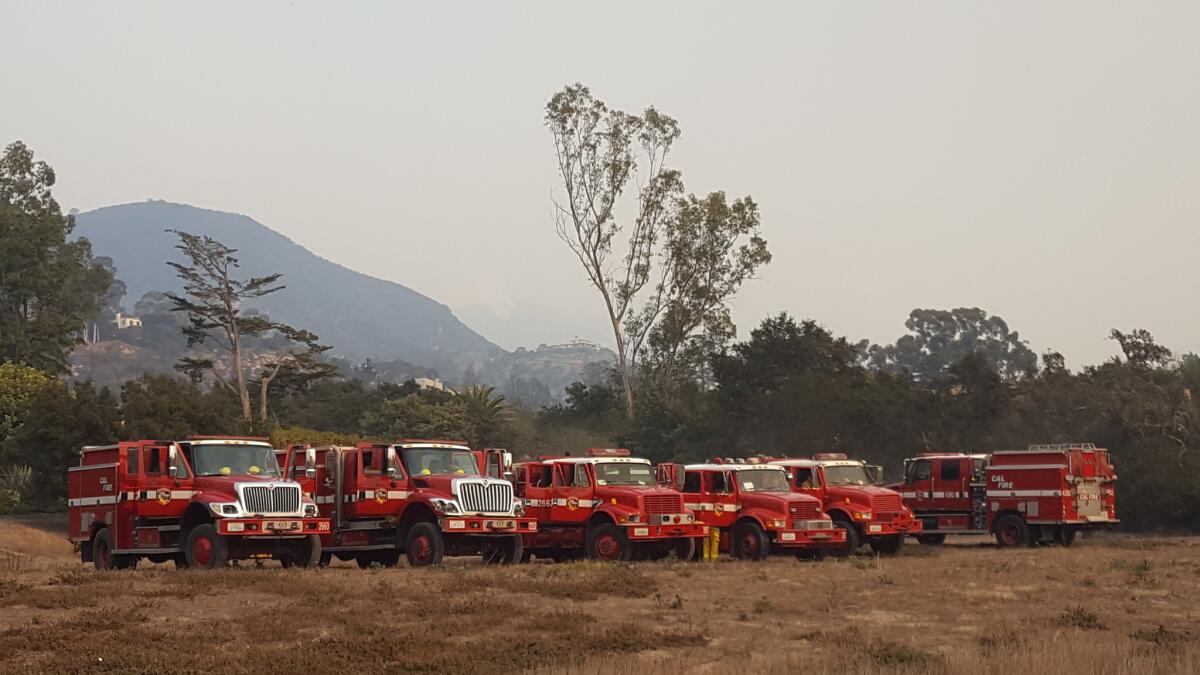
Montecito looked almost like a ghost town Monday.
Stores and gas stations in the evacuation zone north of Highway 192 were closed, and only a scattering of residents remained in the neighborhood.
California Department of Forestry and Fire Protection Fresno-Kings Battalion Chief Roger Raines and his platoon of more than a dozen trucks and water tenders were on hand however. It was their job to assess how vulnerable homes north of the highway between San Ysidro Road and Park Lane were to the incoming fire.
Raines’ defense zone includes about 50 multimillion-dollar estates connected by a tangle of narrow, winding tree-lined roads barely wide enough for the trucks assigned to protect them.
On Monday afternoon he sat in his truck at the intersection of Park Lane and East Mountain Drive, just outside the open field his team designated a safety zone — a place they could regroup if things took a turn for the worse.
“This is our first shift here, but we’ve been running for a week,” Raines said. “We were at the Skirball, then were sent to Riverside and now here.”
With the 230,500-acre Thomas fire still miles to the east, firefighters in Montecito were going door to door Monday to see who did or did not evacuate, which homes had water sources, which had good clearance between their property and the forest and if the home appeared to be defendable should the Thomas fire bear down on the community.
Raines said many of the homes in his zone looked defendable, with tile roofs and gravel landscaping. But, he clarified, that doesn’t mean they’re guaranteed to be safe if powerful sundowner winds blast the flames down onto the area.
Gusty winds pushed the fire seven miles west overnight, he said, and by Monday afternoon ash was falling in the Montecito community. The sky was a grey haze, and the acrid air stings the back of the throat.
The crews assigned to protect the foothill homes Monday evening will be on patrol for any embers that can spark a fire, Raines said.
The Thomas fire isn’t the worst Raines has seen — he was up in Napa County just two months ago for the wine country fires — but it was unusual.
“It’s December,” he said. “This doesn’t happen in December.”
- Share via
Ash and silence blanket beach community of Summerland
The quaint eateries, coffee shops and wine shops along Lillie Drive in Summerland were closed or empty Monday as ash fell on the quiet beach town in Santa Barbara County. Residents walked their dogs and checked the daily fire map posted on a board outside the local fire station.
Up along State Route 192, Laurent Pellerin wore a surgical mask as he packed his red Audi station wagon with winter clothes and snow chains.
The 48-year-old home decor store manager was getting ready to drive his family to Chicago for a new job when the fire closed in on his cottage near Toro Canyon over the weekend. Now they are leaving, unsure if their home will survive after they go.
“It is surreal; we are leaving the fires and rushing to get the snow chains for winter,” he said.
Across the road, a private Wildfire Protection Unit from the Insurer AIG was patrolling one of the high-value homes in the area.
- Share via
Difficult terrain presents challenges for firefighters battling Thomas fire
The last time some of the slopes and canyons burned in the mountains east of Santa Barbara in the 1970s, four firefighters operating bulldozers died in a rollover accident.
In such difficult terrain, officials with the California Department of Forestry and Fire Protection said on Monday that they have essentially no way to get boots and hoses on the ground to attack the western front of the Thomas fire directly.
Instead, fire crews caravanned out of the Ventura County Fairgrounds on Monday and headed to the residential streets in the south-facing foothills of Carpinteria. That’s where they set up defensive positions and waited just in case the fire moved downhill .
“The terrain ... makes it super difficult for us to position with normal tactics,” said Kalin Ramirez, a fire information officer.
While crews stage in town to protect homes, a fleet of fixed wing aircraft will attack flames higher up in the mountains and try to douse the fire directly, Ramirez said.
The Thomas fire has burned 230,500 acres and was 15% contained Monday morning. None of that containment, however, appears to be on the blaze’s western face approaching Santa Barbara.
A rare feature of California’s landscape, the Santa Barbara and Carpinteria communities sit in the shadow of an east-west mountain range that is allowing the flames to run west along its spine, as dry, powerful Santa Ana winds push the blaze.
“We look for rivers, roads and ridges” to set up defenses, Ramirez said.
At night when the air cools, the mass of smoke and ash that were launched skyward by the heat of wildfire can collapse on itself. This creates an outward push of wind and heat out in all directions, further driving the fire, Ramirez said.
Some of the newly burned areas have been turned into a moonscape, Ramirez said. These are typically areas that have not seen flames for decades. These areas are then left vulnerable to mud slides if heavy winter rains ever arrive, officials said.
Moonscaping is when brush burns completely away, “so that the landscape looks like the surface of the moon,” said Ian MacDonald, a public information officer for the Thomas fire.
“That isn’t in all areas, but in some areas that’s what’s happening, which is an indication of what we call extreme fire behavior,” MacDonald said.
- Share via
Redding firefighter who suffered broken leg while battling Thomas fire ‘is in good spirits’
A Redding firefighter who was injured while battling the Thomas fire is returning home, officials said Monday.
The firefighter sustained the injury around 7 a.m. Sunday, the Redding Fire Department said in a statement . He was taken to a Santa Barbara hospital, where doctors treated a fracture to his lower leg.
“Our firefighter is in good spirits and is returning home,” the statement said.
The department said it sent another member to replace the injured firefighter on the assignment.
Since the start of the fire, which is now burning in Ventura and Santa Barbara counties, the Redding Fire Department has committed two battalion chiefs and three engine crews, for a total of of 13 personnel, according to the department.
- Share via
Weaker winds expected as fire crews continue to battle Thomas fire

As the Thomas fire continues to rage, burning more than 200,000 acres, wind speeds are expected to be on the lower end of what’s been seen over the last week, forecasters say.
Over Sunday night and into Monday morning, there were wind gusts of around 20 mph across the lower mountains and foothills in the region of southeastern Santa Barbara County into southwestern Ventura County.
“Wind was probably not the biggest factor last night to this morning — it’s probably more the complex terrain, very dry and possibly widespread fuels for the fire and the fact that it’s a pretty large and ongoing fire,” said Robbie Munroe, a meteorologist with the National Weather Service.
“The light offshore winds are certainly a factor, but not as important as they’ve been, say, earlier in the week when we saw much stronger winds over the fire.”
The strongest winds are expected more toward the Ventura-Los Angeles County line, Munroe said.
“Even that is not expected to be particularly strong, but since it’s so dry out there it doesn’t take much in the way of winds to create those critical fire weather conditions,” he said. “We’ll see wind gusts in that ... area between 20 and 35 mph, maybe a few mountain sites might see up to about 40, but that’s the most we’re expecting right now.”
The winds near the Thomas fire might be a little bit stronger later on Monday night into early Tuesday morning from the north, Munroe said, possibly 5 mph stronger.
“Right now it doesn’t look too terribly strong, but really any increase in wind is something to watch out for given this fire’s history.”
- Share via
When he looked outside, he saw what looked like snow: ‘It was ash, lots of ash’ from the Thomas fire
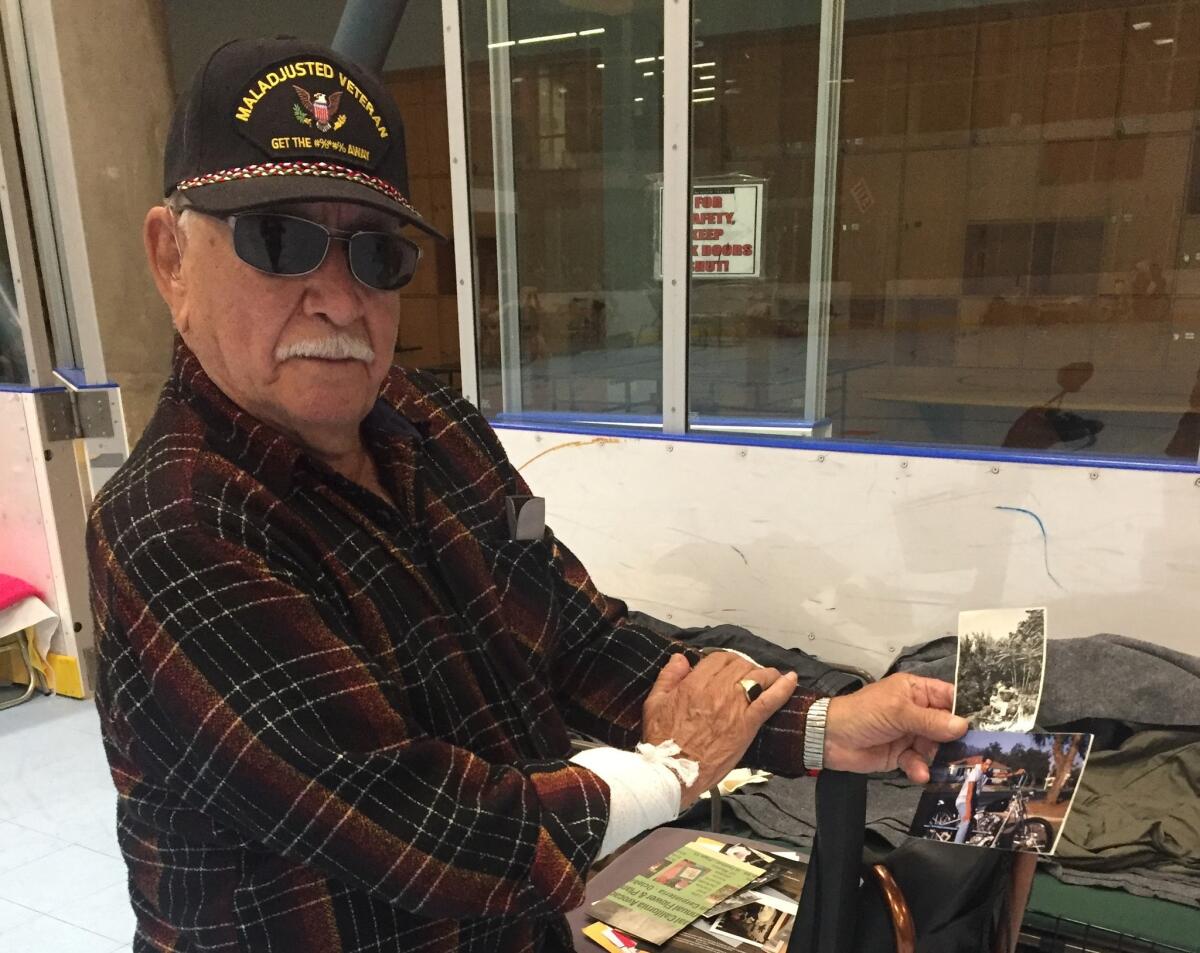
Carlos Guerra couldn’t breathe.
There was smoke in the air and the 89-year-old didn’t know where it was coming from. So he opened the door to his trailer home in Carpinteria last week and saw snow.
“It looked that way at least,” he said. “It was ash, lots of ash.”
Concerned for his health, his neighbors called a Lyft driver to take him to an evacuation center in Santa Barbara. Guerra’s neighborhood has been under voluntary evacuation orders since the Thomas fire began inching closer to his coastal town.
At UC Santa Barbara, the Red Cross gave him a cot and began tending to his medical needs, including taking him to a nearby hospital to get a bad bug bite tended to.
“I’m so grateful for everyone here,” he said.
What he left his home with sat by his cot at the center: an envelope of photos and his motorized wheelchair scooter.
“I also took with me a sense of security,” he said smiling. “I’m being taken care of and, to be honest, I’m not worried if I lose my home.”
He said he was grateful organizations such as the Red Cross are available for people like him.
“Who knows what situation I would have found myself in if I had stayed home,” he said.
- Share via
These are the Santa Barbara schools that will be closed until after the New Year
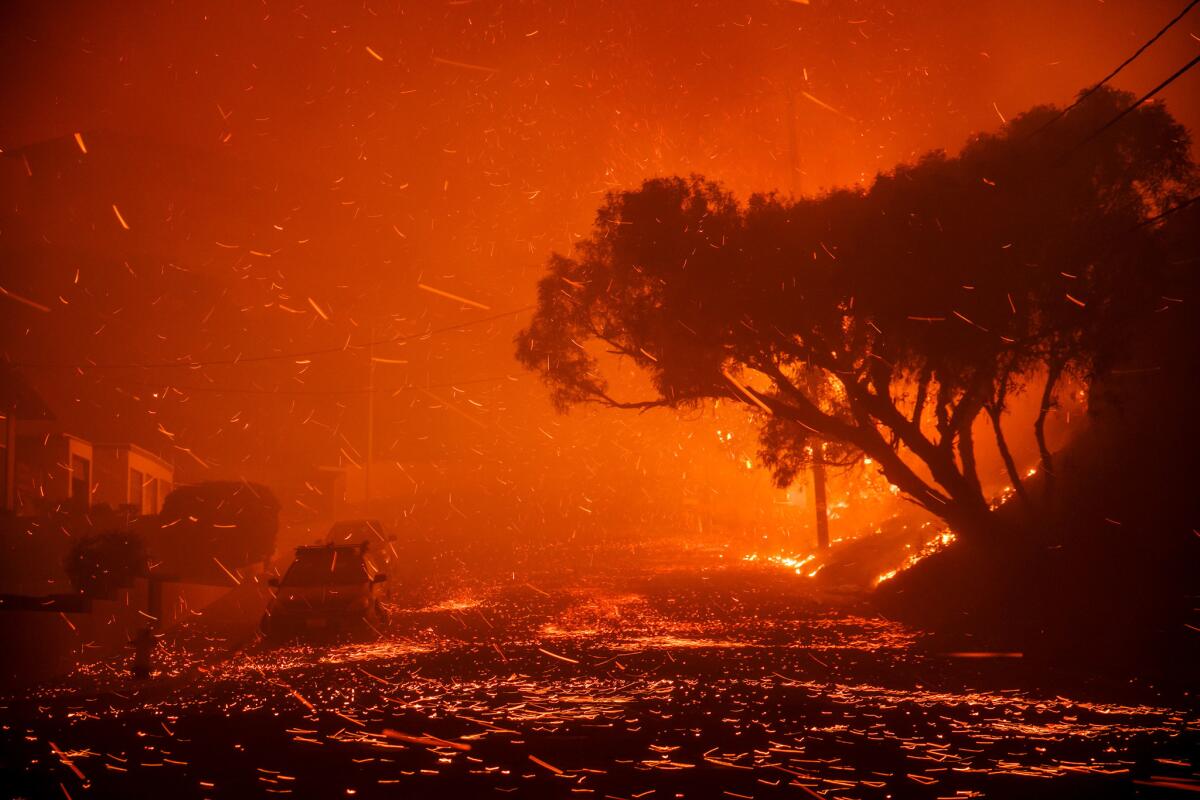
As fire crews fought to get a handle on the raging Thomas fire, all but one school district in Santa Barbara County decided to cancel Monday classes, officials said late Sunday.
Several of those districts — including Carpinteria Unified, Montecito Unified, Cold Spring, Santa Barbara Unified, Hope Elementary and Goleta — will be closed until after the New Year. Students had been scheduled to start winter break Dec. 18.
Meanwhile, UC Santa Barbara Chancellor Henry T. Yang announced that the university has postponed final exams until next year.
Power outages and air quality issues, along with the confusion over an emergency alert that buzzed cellphones countywide around 2 a.m. “have only continued to raise the level of anxiety at an already stressful time,” Yang wrote in a letter to the campus. “Continuation of scheduled exams has become untenable.”
- Share via
These are the five largest wildfires in modern California history
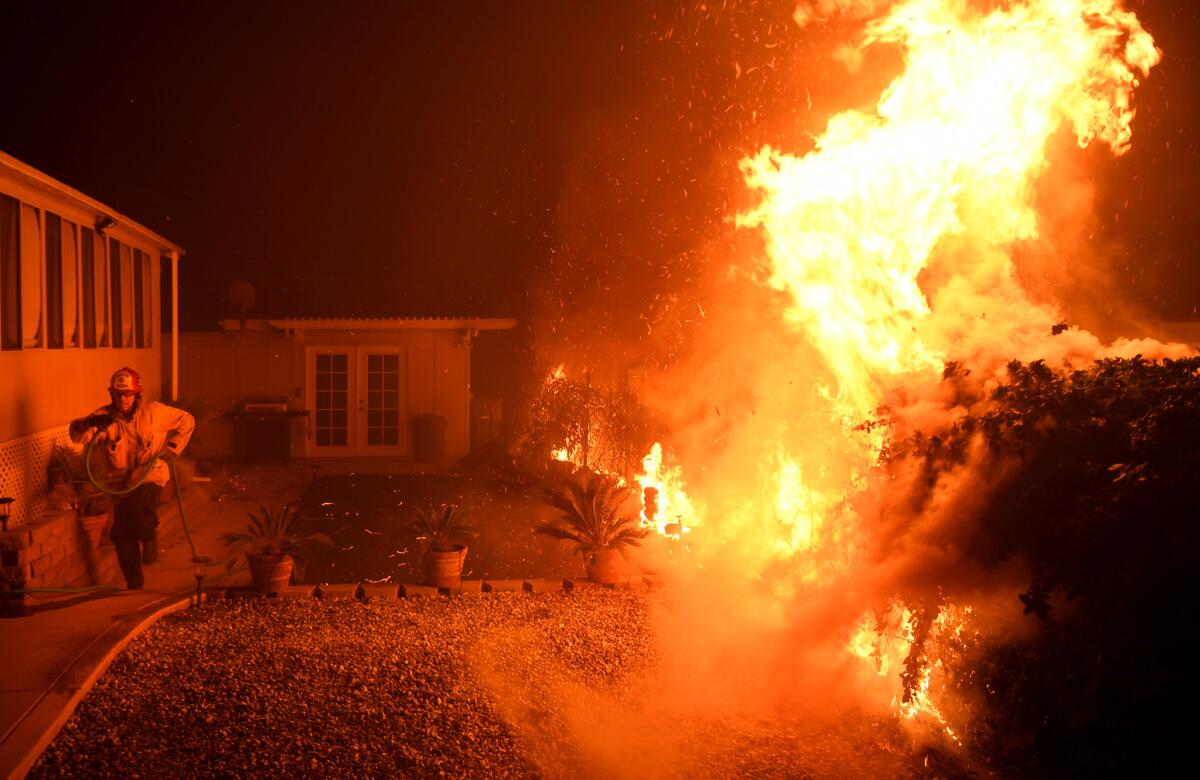
Since it started Monday, the Thomas fire has scorched 230,000 acres, making it the fifth-largest wildfire in modern California history.
Here’s a look at the others:
- The Cedar fire burned 273,246 acres in San Diego County in 2003. More than 2,800 structures were destroyed and 15 people died.
- The Rush fire, caused by lightning, burned 271,911 acres in California and another 43,666 in Nevada in 2012.
- The Rim fire in Tuolumne County in 2013 burned 257,314 acres and consumed 112 structures.
- The Zaca fire in Santa Barbara County in 2007 charred 240,207 acres and destroyed one structure.
- The Thomas fire surpassed the Matilija fire — which scorched 220,000 acres in Ventura County in 1932 — as the fifth largest wildfire.
While other large fires raged in California prior to 1932, those records are less reliable, according to the California Department of Forestry and Fire Protection.
- Share via
At 230,000 acres, Thomas fire is now the fifth largest wildfire in modern California history
Santa Barbara County was under siege from the Thomas fire Sunday as fire crews fought to keep the destructive blaze from the region’s picturesque beach communities.
Authorities said the out-of-control blaze had scorched 230,000 acres by Sunday evening, making it the fifth largest wildfire in modern California history.
The fire grew by more than 50,000 acres during the day, triggering new evacuation orders for about 5,000 county residents, including those east of Mission Canyon and north of Highway 192. An additional 30,000 residents west of Mission Canyon to Highway 154 and south of Highway 192 to the county line were told to prepare to leave.
- Share via
Fires threaten power lines serving thousands in Santa Barbara and Ventura
Nearly 3,000 households and businesses in Santa Barbara and Ventura counties have been impacted by the Thomas fire, which has burned 155,000 acres since Monday, according to Southern California Edison.
The fire continues to threaten transmission lines serving the Santa Barbara area. As of 11:12 a.m., up to 85,000 customers in the Santa Barbara area were experiencing intermittent outages and power surges. In the Ventura area, 3,211 customers were experiencing outages.
Out of the 305 damaged poles, 58 have been replaced, but progress will be determined by weather, terrain and the movement of the fire, the company said on its website.
“When fully assessed, we anticipate the magnitude of the damage to be extensive,” said the utility.
UPDATES
11:15 a.m.: This story has been updated with specific numbers for the Santa Barbara and Ventura areas.
7:05 a.m.: This story has been updated with more customers — 89,017 — experiencing power outages as of Sunday morning.
This story originally published at 4:35 a.m.
- Share via
Here are the areas in Santa Barbara County with evacuation orders or warnings
- Share via
His home ‘had views to die for’ -- destroyed in seconds by San Diego’s Lilac fire
Saturday on Wrightwood Road in Bonsall was a time for sifting — sifting through memories, through tears, through ashes.
When the Lilac fire blew through here Thursday afternoon, it burned down at least seven houses on this hilly street, and it would have been worse if firefighters and a half-dozen neighbors hadn’t been there to put out flames that in some places licked to within a few feet of the outside walls.
So along with the lingering smell of wood smoke, there was a swirl of emotion up and down the road Saturday morning. People who lost their houses were grateful to be alive. Those whose houses still stood felt relieved, but also a little guilty, and they grieved for what their neighbors were going through.
It’s a street where everybody seems to know everybody else, if not by name then at least by sight. They shared hugs as some of them returned to their properties for the first time since the fire broke out.
Veterinarian Geoffrey Smith came back to the rubble of what had been a two-story, four-bedroom, 2,250-square-foot house. He’s lived there since 1980 with his wife, and more recently also with his 93-year-old mother. They raised four kids there.
“It had views to die for,” he said. “It was also made out of wood, which is why it burned down.”
- Share via
San Diego County’s Lilac fire devastates retirement community
John Knapp didn’t know what he would find when he returned to his home in the Rancho Monserate Country Club retirement community Friday morning, a day after the Lilac fire swept through.
Dozens of the 230 carefully kept manufactured houses, lined up in neat, hillside rows, burned to the ground in the wildfire that covered nearly 4,000 acres in about 12 hours. Residents had just minutes to evacuate.
“I thought I saw it burning on TV last night,” Knapp said as he rushed up the street toward his place.
As he got close, he could only see part of the house. He wondered aloud whether the house had been damaged. Then he saw the front, good as new.
“It’s still there!” he shouted. “As much smoke as this place was putting out, I thought they were all burning. I’ll be damned. I can’t believe it.”
The wildfire started about 11:30 a.m. Thursday near the intersection of Interstate 15 and state Route 76. Almost immediately, the dry, gusty Santa Ana winds carried the flames west across the nearby Rancho Monserate community in Fallbrook and into the mostly rural area of the San Luis Rey River valley.
Not everyone was as fortunate as Knapp.
- Share via
Evacuations in Carpinteria, Montecito
Evacuations were ordered in parts of Carpinteria and Montecito as the Thomas fire moved into Santa Barbara County’s southern coast.
The Santa Barbara County Fire Department said at least one home was burned.
- Share via
Brush fire breaks out in Monrovia
A brush fire that ignited in Monrovia on Saturday night prompted evacuations of residents along Norumbega Dr. and a large group of Boy Scouts.
Initial reports suggest the fire broke out near the foothills of the Angeles National Forest, north of the 210 freeway. It’s estimated to have burned three acres.
The evacuees included a group of Cub Scouts and Boy Scouts who were staying at Camp Trask, a campsite in the foothills of the national forest. They were there for a shooting sports weekend.
A member of the group, David Hilton, estimated there were as many as 150 people at the camp, including troop leaders. He said the Scouts learned about the fire from a forest ranger who came to tell them they were all being evacuated.
“The fire is near us but it’s down at the bottom of the canyon,” Hilton said. “Everybody’s getting out. Looks like we’re safe.”
U.S. Forest Service firefighters, who responded along with the Los Angeles County Fire Department, described the blaze as “terrain & fuels-driven.”
- Share via
At least 46 horses dead after San Diego County wildfire
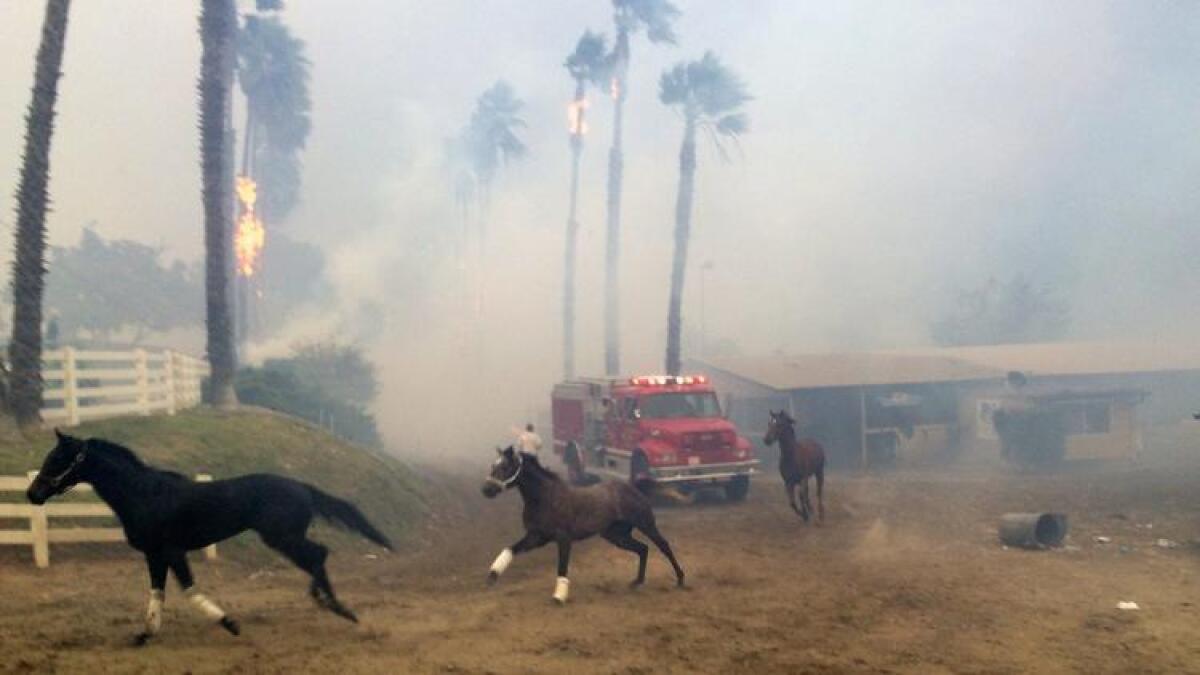
At least 46 horses were killed at a thoroughbred training facility during the Lilac wildfire in northern San Diego County, and others remain missing.
Mike Marten, a spokesman for the California Horse Racing Board, said Saturday that the death toll at San Luis Rey Downs could rise. He said the thoroughbred facility in Bonsall accommodates 495 horses and that at least 450 were there when the fire struck on Thursday.
Marten said a small number of horses escaped to the wilderness through a fence that was knocked down and haven’t been located.
- Share via
‘We’re facing a new reality in this state,’ Gov. Jerry Brown says of wildfires

Gov. Jerry Brown on Saturday surveyed the devastation in Ventura, the city hardest hit by this week’s firestorms. Brown’s visit comes four days after he declared a state of emergency.
In all, there are six wildfires burning in Southern California. About 8,500 firefighters are battling the fires, which have collectively burned 175,000 acres.
“We’re facing a new reality in this state, where fires threatened people’s lives, their properties, their neighborhoods and billions and billions of dollars. So we have to have the resources to combat the fires,” he told reporters during a news conference at the Ventura County Fairgrounds.
The governor thanked firefighters for their efforts and expressed sympathy for residents who had lost their homes and animals, calling it a “horror” and “terrible tragedy for so many people.”
Brown added that climate change may exacerbate the weather conditions that caused the wildfires to explode.
“This is the new normal, and this could be something that happens every year or every few years,” he said. “We’re about to have a firefighting Christmas.”
- Share via
In a neighborhood hit hard by Thomas fire, one family arrives to find their home spared
With improved air quality on Saturday morning, residents in the Ondulando area of Ventura returned to check on their homes. Members of the National Guard stood outside on street corners to protect people’s property.
The neighborhood was one of the hardest hit by the Thomas fire. Rows of homes on streets that sit near the hillside were incinerated.
Terry Davis and his wife, Tahnil Davis, arrived Saturday to check on their home on Via Arroyo Street, which had been spared by the fire. They give credit to their 12-year-old daughter’s passion for softball for saving theirs and their neighbors’ houses.
“We happened to be building a batting cage for her so our backyard was completely gutted,” Tahnil Davis said. “Firefighters were able to park their truck in our backyard and save homes.”
The family bought their house in August. They said they were taken aback by the community’s positive attitude despite losing so much.
“We wanted to move here because people in Ventura are so nice,” Tahnil Davis said. “But now I really know we made the right decision.”
- Share via
Efforts to battle the Thomas Fire in Ventura County have cost $17 million so far, officials say
Efforts to battle the Thomas fire in Ventura County have cost $17 million since the blaze first exploded on Monday, officials said Saturday.
Crews working from helicopters and air tankers have dropped 712,000 gallons of fire suppressant across the fire. The retardant includes a mixture of water, foam and fertilizer, which helps vegetation grow back after a fire.
Wind has been a consistent threat throughout the week, and meteorologists advised fire officials that the Santa Ana winds could return Saturday afternoon. If that happens, winds could push the fire toward Santa Barbara County, including the coastal communities of Carpinteria and Summerland.
Bulldozers have been working to build fire breaks near that portion of the fire, in case the blaze does make a run toward Carpinteria, said Rich Macklin, a spokesman for the Ventura County Fire Department.
Near Fillmore, firefighters are working to contain a blaze burning through the backcountry.
“This is a complex fire,” Macklin said. “There are hundreds and hundreds and hundreds of men and women with packs on their backs, squirting the hills, putting the wet stuff on the red stuff.”
Earlier this week, Ventura County Fire Chief Mark Lorenzen estimated that if the winds continue and the area sees no rain, the Thomas fire could continue burning for weeks.
An estimated 87,000 people have evacuated since Monday. As people return to their homes, Macklin cautioned them to keep an eye out for downed power lines, damaged gas lines and any other threats.
- Share via
Dogs trained for disaster relief were displaced by the Thomas fire. Their trainers are using it as a learning experience
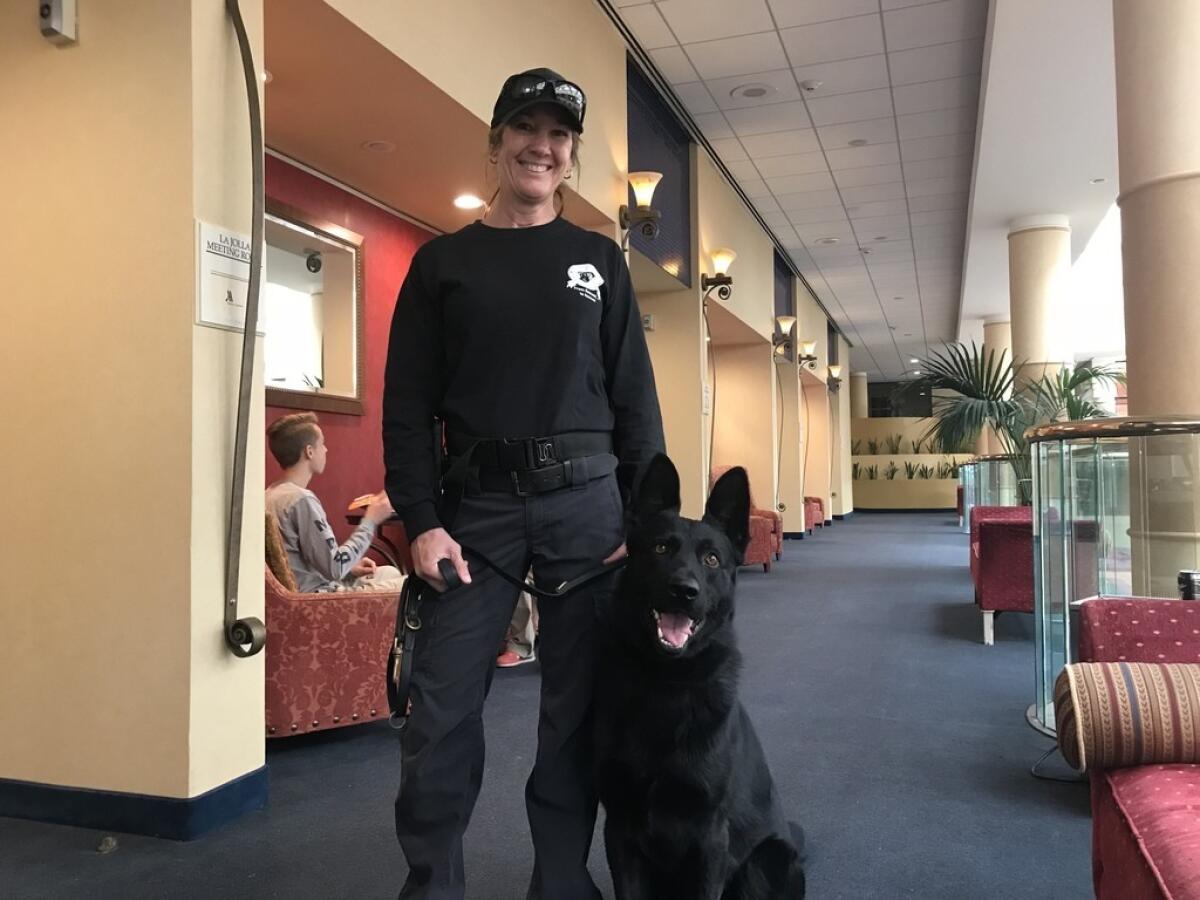
When Sonja Heritage walked inside a small meeting room at the second floor of the Marriott Hotel in Ventura, nearly 20 dogs in their kennels started wagging their tails and barking in excitement.
Heritage is the head canine trainer at the National Disaster Search Dog Foundation, one of the only nonprofits in the nation that takes shelter dogs and trains them in disaster relief search and rescue missions and provides them free of charge to handlers at fire departments and other first response agencies, said spokeswoman Denise Sanders.
The organization has trained 184 dogs on its property in Wheeler Canyon Road in Santa Paula, Sanders said. Their dogs have assisted in search and rescue missions at ground zero after 9/11, the Haiti earthquake in 2010 and most recently in Houston after Hurricane Harvey.
On Monday, the Thomas fire swept through their 125-acre property, burning parts of the area where they train dogs.
Around eight staff members helped evacuate the nearly 20 dogs on the property. Since then, the animals, along with Heritage and other staff, have been staying at the Marriott Hotel in downtown Ventura, where they care for the dogs.
On Saturday, Heritage was playing with one of the canines — a 2-year-old black German shepherd named Zeek. She tried to yank the ball away from him, but his grip was too tight.
“He’s my heart,” Heritage said. “He reminds me of my dog who died last year.”
All the dogs staying at the Marriott Hotel are being trained to find people buried under rubble, she said.
“These dogs love toys, so we use that as part of training,” Heritage said.
Although the hotel is not an ideal place to house dogs, Heritage is using the displacement as an opportunity to help the animals get acquainted with a different environment.
“It’s good that they’re around so many people,” she said. “We walk them up and down the stairs and throughout the hotel at least eight times a day.”
But she looks forward to returning to Santa Paula and rebuilding parts of the property that were damaged.
“We hope to return in a few days,” she said.
- Share via
Investigators probe cause of San Diego County wildfire
What caused the Lilac fire in San Diego County? Investigators are trying to figure that out.
The fire began about 11:15 a.m. Thursday near the entrance to a mobile home park, off Old Highway 395 about a mile south of State Route 76 and a few hundred feet west of southbound Interstate 15, which runs parallel to the highway.
The fire was reported by motorists while still quite small, according to initial accounts.
Pushed by winds, the blaze ignited brush in a valley between the freeway and the highway and then quickly spread across Old Highway 395 and headed west.
The method of investigating how wildland fires begin has remained virtually the same for decades.
The first order of business is to determine as closely as possible the exact point of origin. Using established scientific methods and often a series of small flags to track a fire’s course, investigators can usually determine a fire’s origin quickly and within a few feet.
“Especially in a wind-driven fire, it’s going to travel in a cone,” said Escondido Fire Department spokesman Dominic Polito.
- Share via
‘Three Musketeers’ save their neighborhood from fire

“The Three Musketeers” of French literary fame fought corruption with rapiers, but the newly nicknamed Three Musketeers of Bonsall fought off a raging firestorm Thursday night with little more than a pair of expired fire hoses.
Neighbors Cathy Orchard and Don Philippbar and his stepson, Todd Smith, ignored evacuation orders and stayed to defend their homes and several others on Redondo Drive, just south of Highway 76. By dawn Friday, they had rescued five houses that were all aflame at many points during the long, windy night.
“It was pretty scary for a while there. You talk about firestorms — this was definitely one,” said Philippbar, 60, a self-employed cabinet-maker. “It was a little freaky inside it — kind of like a tornado passing right over you.”
Grace Yamane, a San Diego Fire battalion chief who did firewatch overnight to give the exhausted trio a few hours sleep, said their efforts were critical in controlling the dozens of continuous spot fires caused by wind-driven embers.
She doesn’t recommend that homeowners ever try to face an approaching fire on their own. But the trio — who jokingly dubbed themselves “musketeers” during their tag-team operation Thursday night — aren’t your typical homeowners. Between them, they have nearly 50 years of combined firefighting experience.
- Share via
More than 100 structures destroyed in Creek fire
Officials on Saturday announced more progress on two fires in Los Angeles County while also offering more information about their destructive force.
The Creek fire, which burned homes in the hills above Sylmar, was now 80% contained. Cal Fire said that blaze burned 56 residences and 49 other structures.
The Rye fire in Santa Clarita was 65% contained. It has destroyed one structure.
- Share via
Some evacuation orders lifted for Ojai
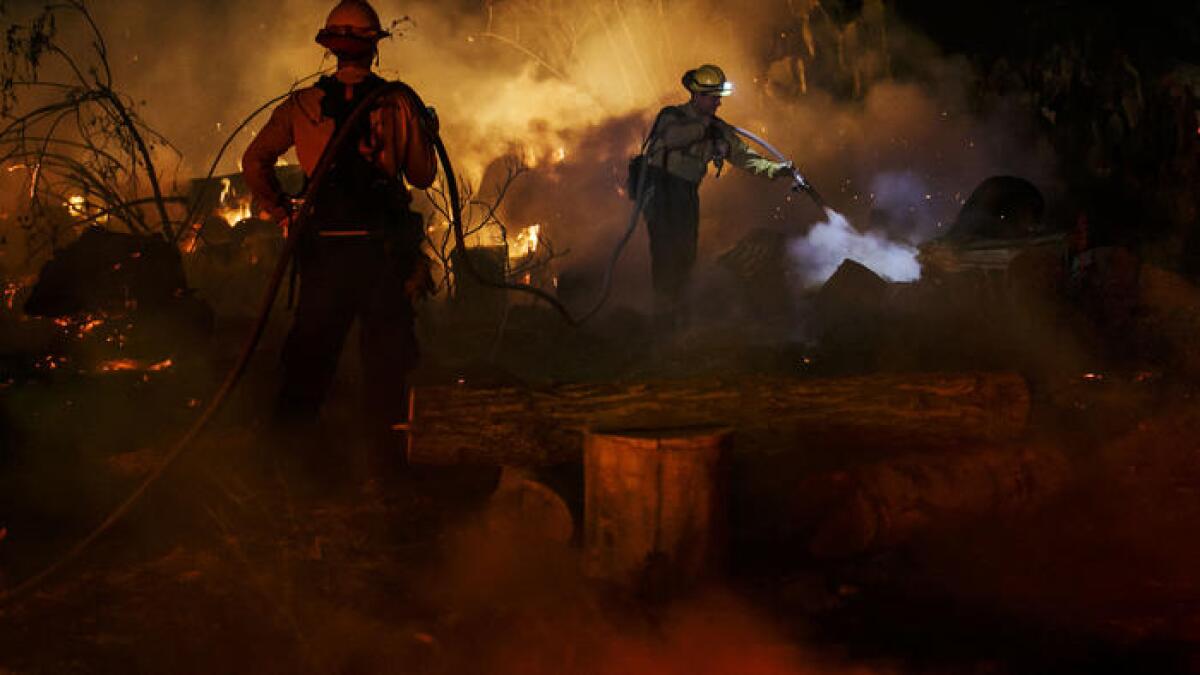
With the Thomas fire in Ventura County 10% contained Friday night, authorities announced they have lifted evacuation orders for parts of the Ojai Valley.
The area includes territory within the city limits, Creek Road, Meiners Oaks from Rice Road east, and unincorporated areas east of the city to Reeves Road, according to the Ventura County Sheriff’s Office.
Areas that remain under evacuation include unincorporated areas west of Rice Road, plus Highway 33 north of Fairview Drive and Highway 150 east of Reeves Road.
The fire has spread across 143,000 acres so far.
For more information go to www.readyventuracounty.org or call 805-654-2551.
- Share via
Authorities report progress on Thomas fire; some evacuation orders lifted
Fire officials said they made good progress Friday due to weakening of the Santa Ana winds. Bill Murphy, public information officer with Cal Fire, said firefighters had a successful day fighting flames on the southern edge toward the coast as well as in parts of Ojai thanks to favorable wind patterns, diminished Santa Anas and crews improving fire lines they had established.
By Friday evening, the Thomas fire had burned 143,000 acres and was at 10% containment. As a result, Murphy said, evacuation orders for most of Ventura and Santa Paula were lifted. Firefighters continued to encounter difficulty on the east side of the fire above Fillmore.
Firefighters used helicopters to drop water in that area to try to contain the blaze. Firefighters also made progress on Highway 33 and U.S. 101 on the west side of the fire. They said activity in that area has decreased from previous days.
Tim Chavez, a fire behavior analyst for Cal Fire, said in previous days firefighters were contending with blazes that were driven by the wind.
On Friday, Chavez said, they were battling fuel-driven fires. “Today’s fire moved slower but with higher intensity, but only in places with heavy fuels,” Chavez said.
Officials at Friday’s news conference estimate the cost of the Thomas fire to be at least $17 million and said that more than 4,000 firefighters are engaged.
- Share via
Thomas fire grows to 143,000 acres, 10% contained
The Thomas fire, which has burned hundreds of homes in Ventura County, has consumed 143,000 acres, officials said Friday evening.
The fire is 10% contained, and officials said firefighters made solid progress Friday as Santa Ana winds weakened.
Many evacuations remain in effect.
- Share via
Skirball fire in Bel-Air is 50% contained
Officials on Friday said the Skirball fire burning in Bel-Air is now 50% contained.
The mayor’s office said evacuation orders remain in place for residents on two stretches of Linda Flora Drive and a stretch of Moraga Drive.
- Share via
San Diego’s 211 emergency call system broke down during firestorm
San Diego County’s much-vaunted emergency communications system was unavailable for a multitude of callers as a runaway wildfire raced across northern San Diego County most of Thursday.
Caller after caller could not connect with a live person for fire information or directions about where to evacuate the Lilac fire.
“I got a recording from Verizon that said the line was disconnected,” said Edward Collins, a retired airline marketing professional who was watching the fire from the backyard of his San Marcos home.
“I assumed it was going to say the area’s under mandatory evacuation and which areas should be concerned, but all I got was a non-working number,” Collins added. “I called several times, and my wife called also. We called on two different cellphones.”
The San Diego Union-Tribune could not get through to the service Thursday afternoon either.
The organization, known as 2-1-1 San Diego, said on Twitter that it was experiencing a high volume of calls but indicated the system was operational.
- Share via
More Santa Ana winds coming to San Diego County fire areas this weekend
Dry Santa Ana winds will roar back to life in San Diego County over the weekend, and some of the strongest gusts could hit the area of the Lilac fire, according to the National Weather Service.
“The winds will begin to gradually pick up on Saturday afternoon, mostly in the East County foothills, from Julian to Alpine,” said Alex Tardy, a weather service forecaster.
“By sunrise Sunday, the winds could be gusting 55 to 65 mph in the foothills. Then the winds will spread out. It looks like they’ll gust 20, 30 and maybe 40 mph where the Lilac fire is. And some of the winds will spread all the way to the coast.”
- Share via
93-year-old man missing in San Diego County fire
For 24 hours since the Lilac fire broke out Thursday, Pat Bailey has been searching for her 93-year-old husband, Ralph.
“He’s been missing since yesterday morning,” she said, after checking the evacuation shelter at Palomar College on Friday morning.
She said her husband is slightly built, gray-haired and bent over and uses a walker. He may have been wearing a turquoise T-shirt, and had a blue and white parakeet with him. Friends helped her call police, fire and sheriff’s officials.
The couple live in the Rancho Monserate Country Club, near the site where the fire broke out in Bonsall on Thursday morning. Pat Bailey was out shopping when the fire erupted and could not reenter the community when she returned.
“They wouldn’t let me into my home,” she said. “I waited all afternoon.”
Police said they moved her husband, she said, but they did not provide information on where he was taken.
“He didn’t have anything with him, except his bird in a cage,” she said.
- Share via
LAUSD schools closed because of the fires are to reopen Monday
All Los Angeles Unified schools closed because of the wildfires will reopen Monday, the district announced.
“The decision to reopen schools was based on improved air quality and the lifting of mandatory evacuations that affecting school communities,” a district advisory stated. Over the weekend, the district is employing crews to install new air filters at the closed schools, and to otherwise prepare them for the return of students.
Many schools across Ventura, Riverside, San Diego and Los Angeles counties were closed Friday because of the fires.
- Share via
Firefighters deploy aircraft to battle the Lilac fire, which led to about 10,000 evacuations
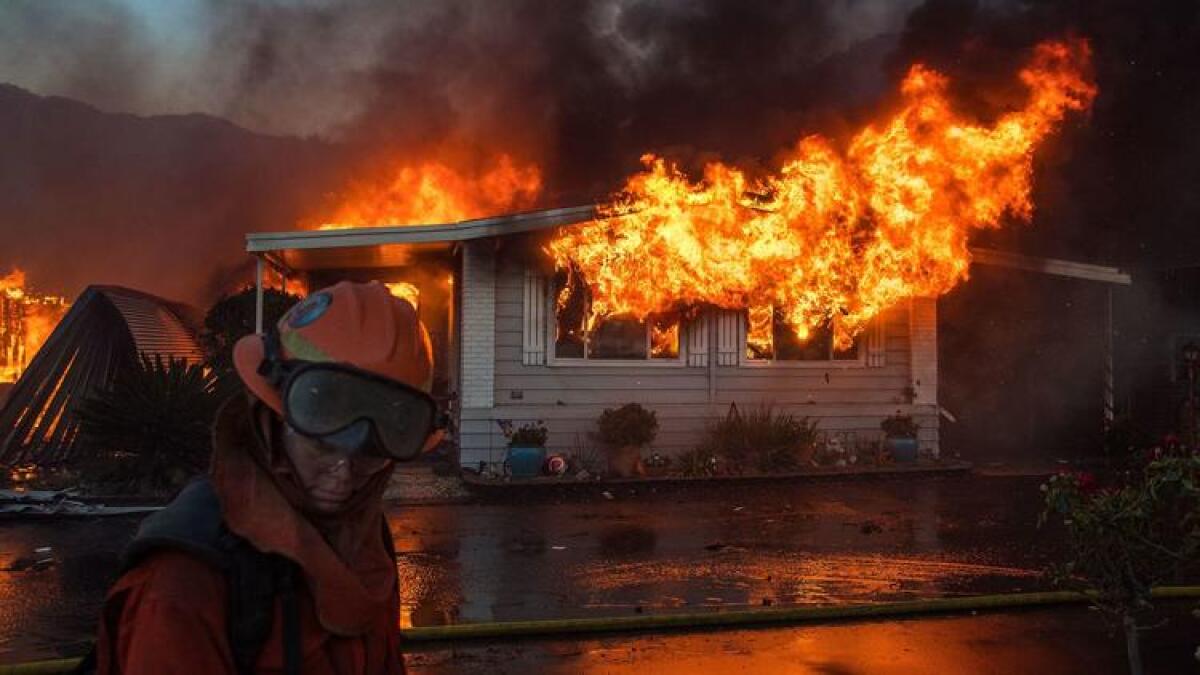
With a fleet of four fixed-winged aircraft, 15 helicopters and more than 1,000 firefighters, state fire officials said Friday they are confident they can keep the Lilac fire at bay and avoid further mandatory evacuations.
An estimated 10,000 residents were evacuated when the Lilac fire broke out near the 15 Freeway in Bonsall on Thursday afternoon and destroyed at least 85 structures, many of them homes.
The fire has grown to 4,100 acres and was 0% contained Friday morning, said Cal Fire San Diego spokesman Kendal Bortisser.
The flames were driven by gusty Santa Ana winds that fanned flames in Riverside, Los Angeles and Ventura counties over the last four days. Firefighters from states spanning the Western U.S. have flooded the region to join the battle.
“When a tornado hits the Midwest, there’s no stopping it,” Bortisser said. “When a hurricane hits the East Coast there’s no stopping. When the Santa Ana winds come in, there’s no stopping them.”
About 850 horses, among countless other animals, were evacuated Thursday night.
- Share via
Size, spread, timing: Some differences between this week’s Southern California fires and fall’s Northern California blazes
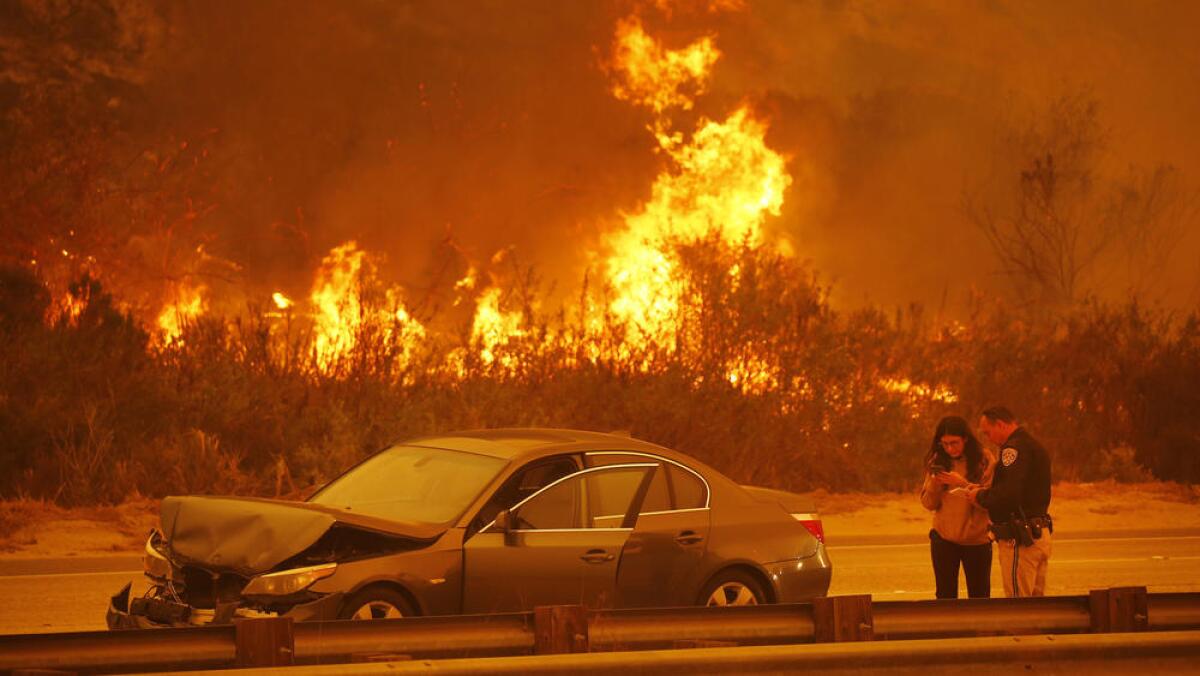
Individually, none of this fall’s fires in Northern California came close to the acreage of the 132,000-acre Thomas fire in Ventura County, though combined, the blazes up north scorched more than 240,000 acres.
The deadliest fire in Northern California, the Tubbs, burned 36,807 acres and was responsible for 22 deaths, sweeping through swaths of Santa Rosa.
Though wind speeds were comparable, “You had 10 large fires within the fires two hours up in Northern California” when the firestorms began, said Cal Fire spokesman Scott McLean, compared to just a few in Southern California.
A number of other factors may also have played a role: The deadliest fires in Northern California ignited later in the night than the Thomas fire in Ventura, which may have contributed to people’s evacuation time, McLean said.
The Tubbs fire ignited at 9:45 p.m., while the Thomas ignited at 6:26 p.m., he said.
“People are up, they’re paying attention, they’re aware … as opposed to waking up out of a dead sleep,” McLean said.
He also pointed out that the median age of the people who died in Northern California was around 70, and many people may have had mobility issues.
The terrain and topographies also differ, and the road system is better in Ventura County, he said.
“It’s hard to put all of the pieces of the puzzle together to determine” what led to more than 40 lost lives in one place and none in another, McLean said.
- Share via
First fire, now smoke: Carpinteria residents line up outside a doughnut shop that’s giving away face masks
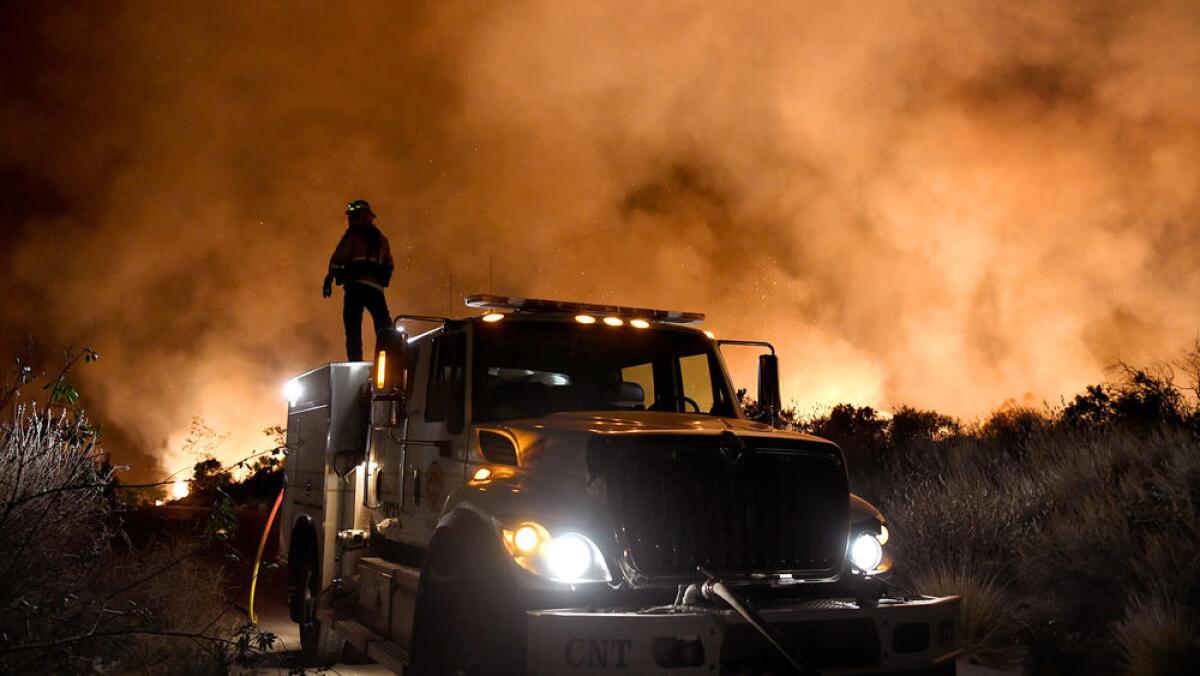
At the Casitas Shopping Center, more than 100 people stood in a line that stretched from Albertson’s to a doughnut shop on the corner.
The residents were there to collect masks as smoke and ash from the Thomas fire had affected the air quality.
Among them was Gloria Rivera, who said she learned about the mask distribution through Facebook.
Rivera, short with black curly hair, said she came to grab masks for herself, her husband and two grandchildren.
Even one for her Chihuahua, Mamba.
“I’m gonna try and put it on him,” she said.
Rivera said she lives in an area where voluntary evacuations have been issued. She said she left home Wednesday as a precaution but returned Thursday to check on her house. She has since decided to stay home.
Also collecting masks for her family was Concepcion Theresa Sexton, who said her daughter, son in-law and three grandchildren were evacuated from Ojai and staying with her until they could return to their home.
She said she won’t be affected by the fire, but air quality has been a major concern for her.
Volunteers with the Community Response Team were handing out green masks to residents.
Organizers said they have 3,000 masks in both adult and children’s sizes to distribute.
- Share via
Southern California’s hospitals prepare for the worst as embers ignite throughout the region
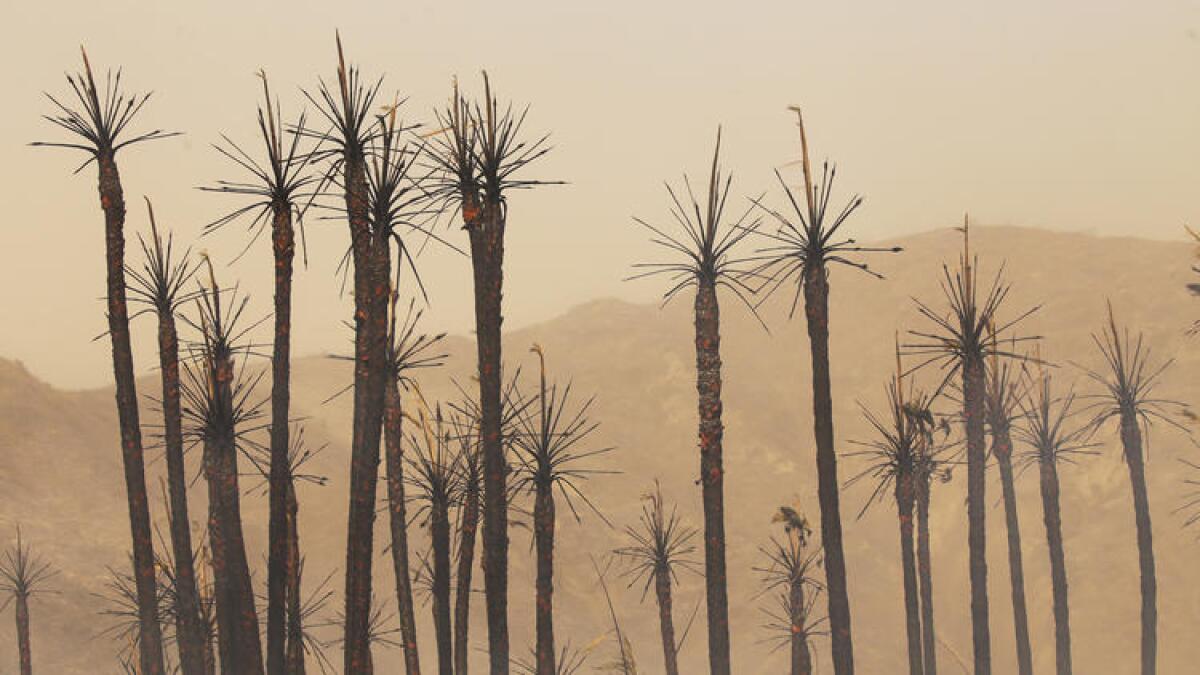
Hospitals across Southern California reported that high numbers of patients with breathing problems caused by this week’s wildfires visited emergency rooms.
Health officials in Ventura, Los Angeles and Santa Barbara counties warned of high pollution levels caused by smoke. The microscopic particles in smoke can penetrate deep into the lungs, creating a hazard for those who already have heart or lung problems such as asthma, emphysema or COPD.
- Share via
‘There’s a lot of dead horses.’ San Diego fire kills many thoroughbreds
Accustomed to the highly-regimented life of the racetrack, hundreds of thoroughbreds frantically galloped together Thursday trying to escape the blazing Lilac wildfire.
Terrified, the speedsters stampeded through Bonsall’s San Luis Rey Downs horse-training facility, whinnying, rolling their eyes and thundering through thick smoke as the fire quickly consumed the barns where they had spent the morning serenely munching hay.
The fire arrived at the sprawling 500-stall complex on Camino Del Rey about one mile east of Highway 76 a bit before 2 p.m., causing ever-more-frantic public address system calls to move the horses to the facility’s one-mile track.
At first, the barn evacuation was orderly, with trainers doing all they could to coax the glossy and muscular bunch up a slight rise that connected the stables to the track.
But the wind picked up suddenly, causing embers to surge westward onto barn roofs, engulfing the whole area in thick smoke, whinnies escaping through the gloom interspersed with frantic calls of “behind you” from trainers trying to keep their friends and colleagues from ending up underneath unpredictable hooves.
Now and then, small herds of horses would gallop from the smoke-shrouded barn bloc, sometimes bolting up to the main track and comparative safety, sometimes opting to keep circling their fiery homes, a maelstrom of confused and panicked horseflesh with no clear compass.
Trainer Linda Thrash of Bonsall was in the middle of that confusion, trying to lead the 41 horses that the company she works for stables in barn L at the Downs to safety.
“We tried to keep up with it, stomping on embers and using the hose, but it just started coming so fast that we just couldn’t stay with it,” Thrash said. “Eventually, we just had to turn them loose. There was not time to do anything else.”
Barns, she noted, tend to be full of flammable material that makes keeping up with a wind-driven blaze more difficult.
As dozens, then hundreds of horses were turned out of their stalls, trainers and other personnel tried frantically to get them under control. Eventually, most calmed down enough to be loaded onto trailers destined for the stables at Del Mar Fairgrounds. But there was a time there in the middle of the action where it seemed like many of the horses would never stop moving long enough to be coaxed in the right direction.
With visibility very low, and thousand-pound animals moving in often-random directions, trampling was a very real possibility. But that did not appear to have happened Thursday afternoon. A Downs employee who declined to give his name said he was unaware of any cases where people were run down.
The horses were not so lucky.
Trainer Brian Kozak said he saw several had collapsed on the track and more died in the barns.
“There’s a lot of dead horses,” he said. “A lot of them just didn’t get out of their stalls and got asphyxiated.”
- Share via
Why there are no confirmed fire-linked deaths or missing person reports in the Thomas fire
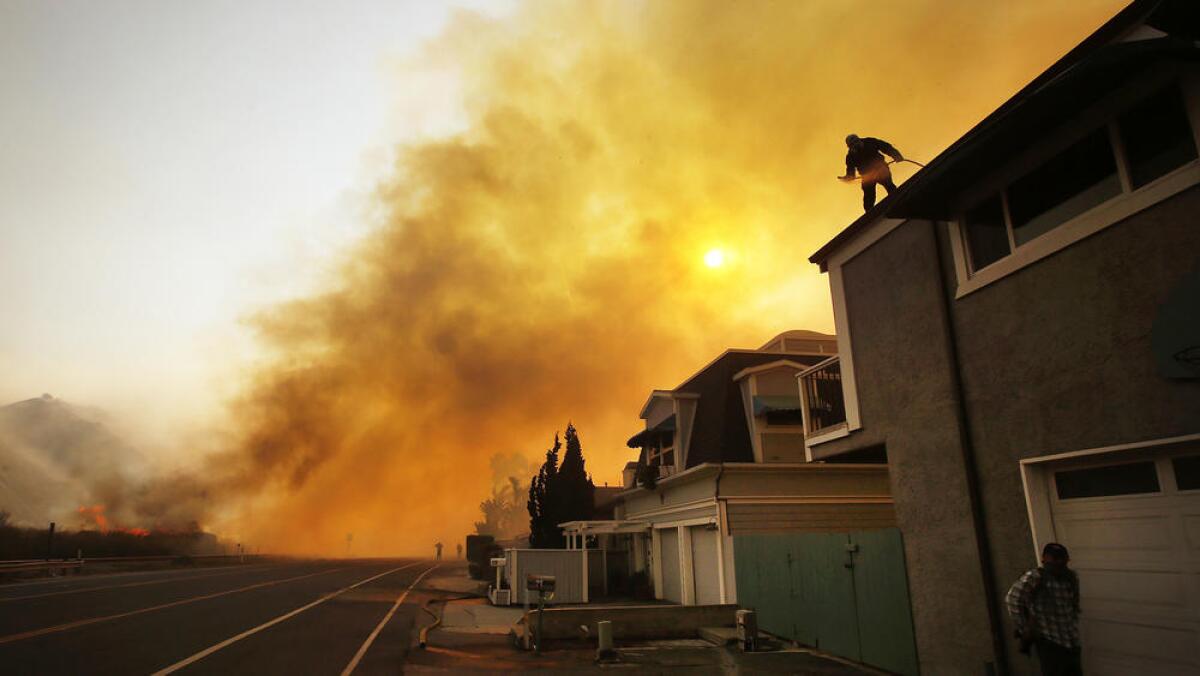
Fire officials said residents in Ventura County who quickly obeyed evacuation orders were the main reason why confirmed deaths linked to the fires have been avoided.
“It’s not easy to evacuate so many people, especially with a fire moving this fast,” said Ventura County Fire Department spokesman Scott Quirarte.
Nearly 27,000 people obeyed the alerts that appeared on their phones and which they received from officials who ordered the evacuation at the start of the Thomas fire, Quirarte said. “People didn’t wait around. People followed the orders, and there wasn’t any delay.”
As of Friday, Ventura County Sheriff’s Sgt. Kevin Donoghue said that there are no missing persons reports linked to the fire and that all people initially thought missing have been accounted for.
Donoghue credits social media and cellphone alert systems as well as “old-school” door-knocking for spreading the urgency of the evacuation orders and preventing deaths. “With what happened in the Northern California fires with loss of life, people here didn’t want that to happen,” he said. “So they listened.”
- Share via
View Thomas fire damage from the streets of a Ventura neighborhood
The Thomas fire started northeast of Ventura and spread through a largely uninhabited mountainous area before reaching the city of Ventura. Colina Vista was a street that suffered extreme damage, with many houses destroyed in the blaze.
Photographer Brian van der Brug captured these 360-degree images of Colina Vista.
- Share via
Red flag fire conditions in most areas continue through Sunday, but winds are slowing down
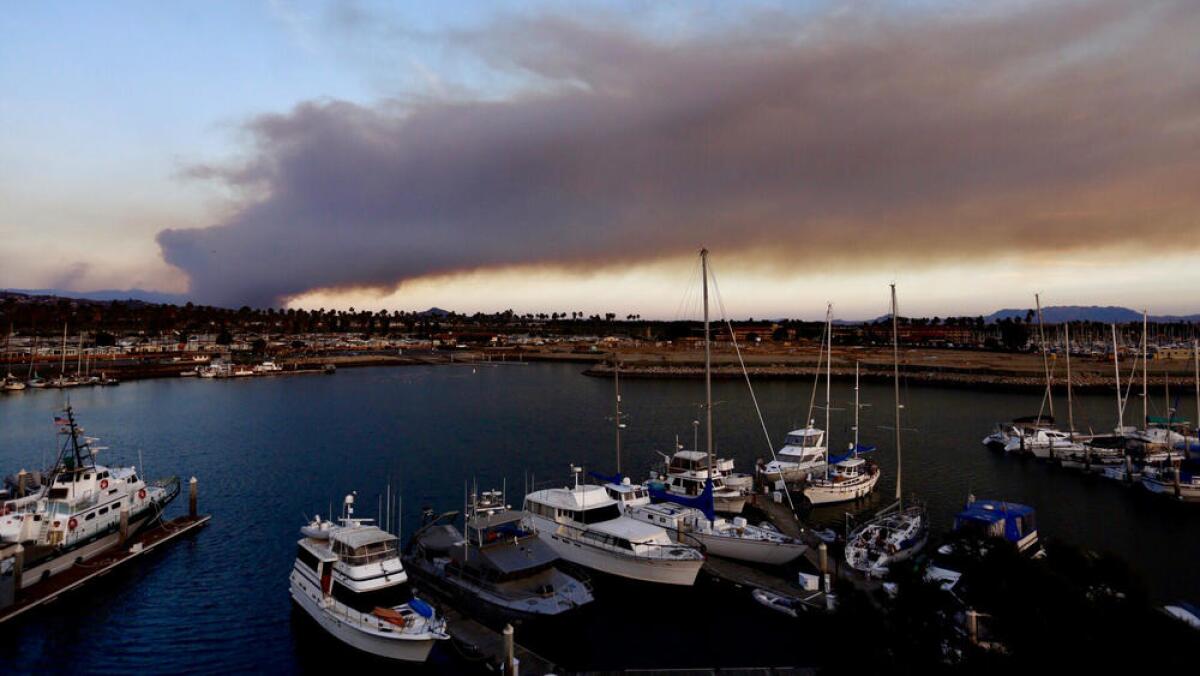
The dry, gusty winds that have fanned a half dozen wildfires in Southern California will continue through next week, the National Weather Service said.
Red flag conditions – a combination of extremely low relative humidity and wind speeds that indicate a serious threat if a fire were to occur – are in effect through 8 p.m. Sunday, said meteorologist Tom Fisher.
“Monday and Tuesday, things should be kind of dull, fortunately,” Fisher said.
The wind speeds expected Friday are a far cry from the hurricane-force gusts that drove a wall of fire into Ventura on Monday evening and down toward more than 100,000 residents in the San Fernando Valley in Los Angeles County the following morning.
According to forecasters, winds ranging from 25 to 35 mph in Ventura County around the Thomas fire will continue to push the fire south and southwest with the occasional 45 mph gusts.
Winds will be even calmer inland, where they will move at 15 to 25 mph with 35 mph gusts in the San Gabriel Valley, Fisher said.
Farther south in Orange, Riverside and San Diego counties, winds have slowed tremendously from Monday and Tuesday, where gusts clocked in at more than 80 mph, down to between 30 and 50 mph for cities between Riverside and Palomar on Friday.
Two fires broke out in those areas Thursday afternoon and have scorched more than 4,000 acres and destroyed dozens of structures.
- Share via
Firefighters warned of erratic winds as they continue to battle Thomas fire
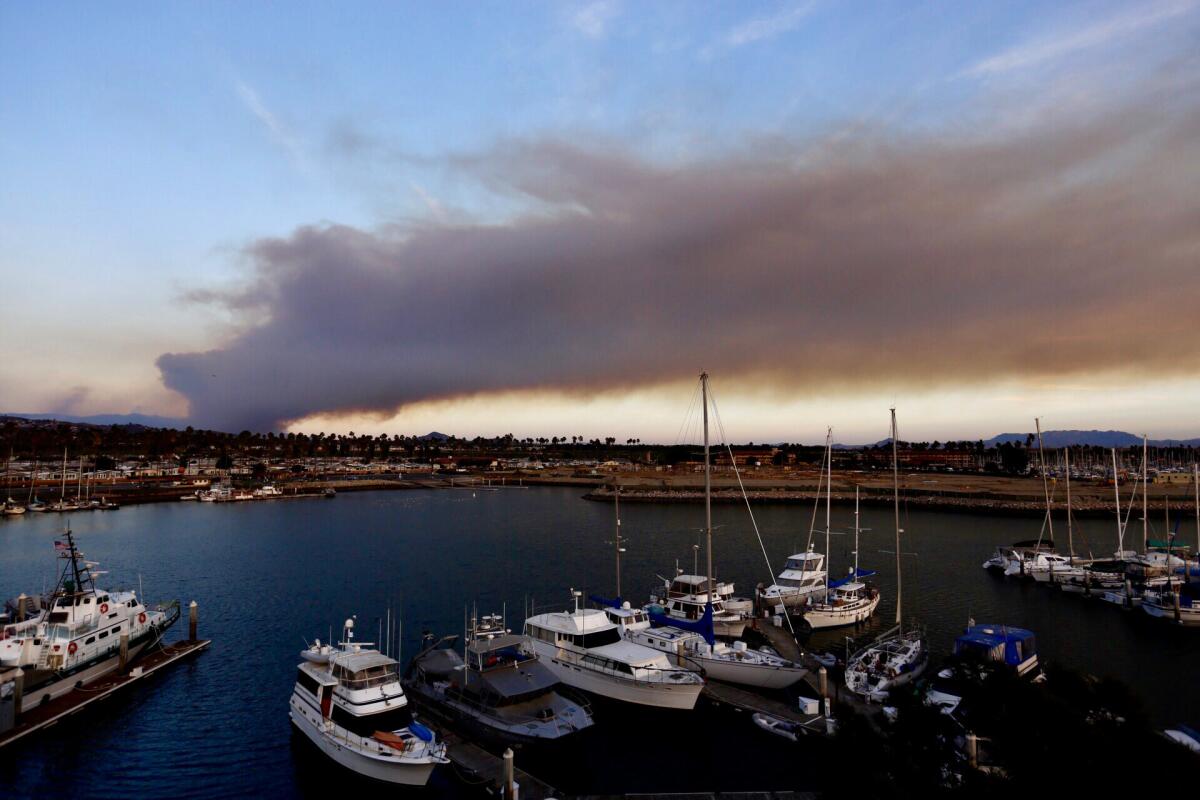
As firefighters gathered Friday morning for another day battling the Thomas Fire, officials told them to be sensitive to residents who were going to find out their homes were razed.
“Treat them like you would treat your community,” fire officials told firefighters on Friday morning as started new shifts.
Firefighters were also warned of the dangers of changing wind patterns and told to be even more cautious of their surroundings. Erratic wind patterns Friday could change direction of flames, putting them at higher risk of getting caught without an escape route.
“The Santa Ana winds are predicted to die down by the afternoon and with that the breeze from the ocean will pick up,” said Ventura County Fire Department Public Information Officer Scott Quirarte. “Firefighters will need to pay attention to the winds and the type of terrain their on.”
Santa Ana winds are expected to pick up by evening, officials said. So far, no firefighters have had major injuries. Officials at the briefing said there have been four minor injuries.
The Thomas Fire has so far consumed 132,000 acres and is 10% contained. Officials are currently trying to assess damage done to property in areas hidden by thick brush.
There will be 22 helicopters fighting the flames from above. Residents in parts of Carpinteria were issued a mandatory evacuation notice on Thursday as flames threatened to hop over in the Santa Barbara county lines.
- Share via
Trump approves California’s emergency declaration request
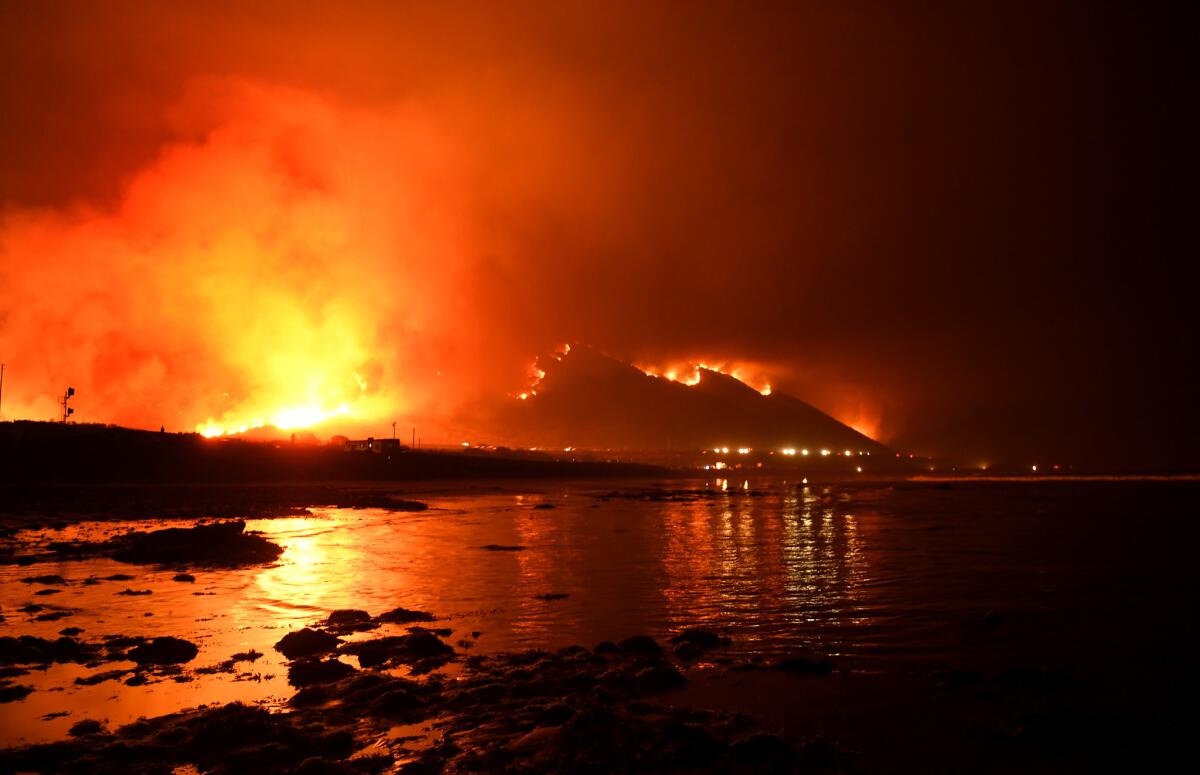
President Trump approved California’s request for an emergency declaration Friday.
According to a White House press release, Trump ordered federal assistance to help the state respond to the wildfires that blazed across Southern California this week.
The declaration allows the Federal Emergency Management Agency to coordinate disaster relief efforts. “This action will help alleviate the hardship and suffering that the emergency may inflict on the local population,” the release said.
FEMA can send equipment and other resources. The help will attempt to “avert the threat of a catastrophe” across Los Angeles, Riverside, San Diego, Santa Barbara and Ventura counties.
FEMA can identify, mobilize and provide, at its discretion, equipment and resources necessary to alleviate the impacts of the emergency. FEMA installed Mark Armstrong as the coordinator for federal assistance for the fires.
- Share via
Over 250 LAUSD schools are closed Friday, but families still can get meals at these campuses
- Share via
As emergency radio chatter slows in Ojai, residents contemplate the fate of their property
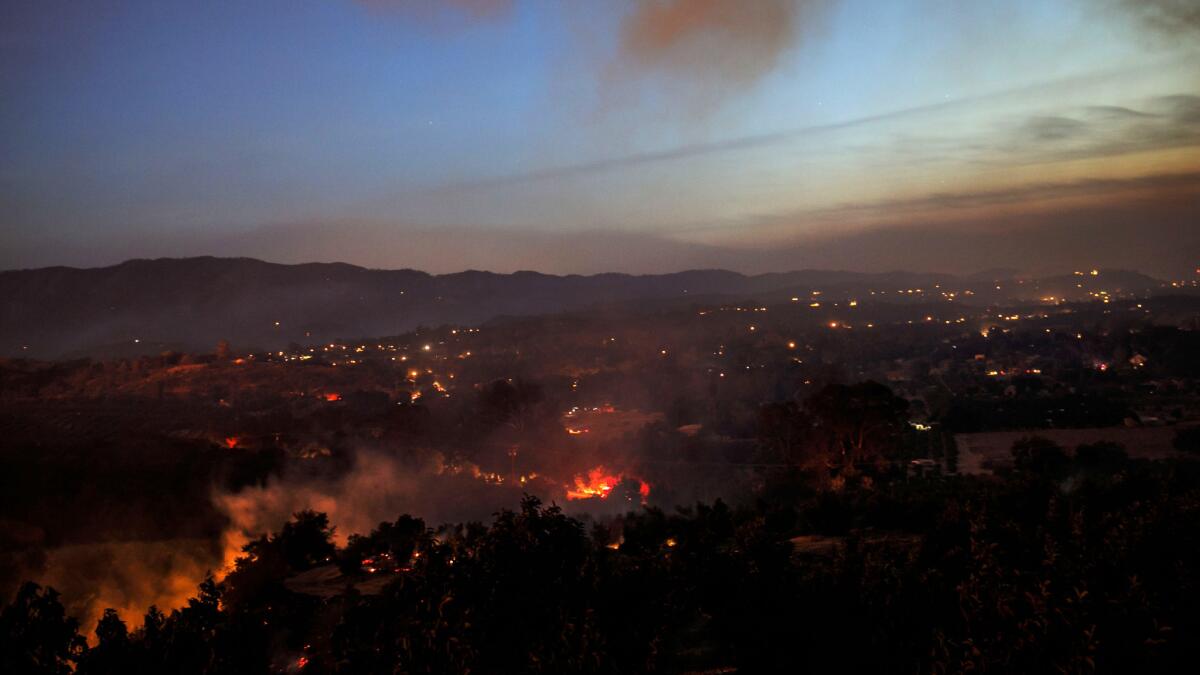
As he has each morning since the Thomas fire triggered mandatory evacuation orders in Ojai Valley three days ago, Ken Williams leaned back in a folding chair at a Red Cross shelter and flicked the switch of an amateur radio console.
The radio enabled him to keep track of the chatter on emergency response channels, and provided a sense of the fire’s behavior.
But something remarkable happened when he turned it on at daybreak Friday.
Silence.
“Man, that’s a good thing,” said Williams, 71, who resides in a mobile home park near downtown Ojai,
“When the chatter calms down,” he said with a smile, “it means things are definitely getting better.”
In the meantime, mandatory evacuation orders remained in place for portions of eastern and upper Ojai Valley. In downtown Ojai, which is under voluntary evacuation orders, most restaurants, boutiques and wine tasting rooms have been closed for three days.
Sitting near Williams was John Wilson, 80, one of 118 people taking refuge in the shelter at Ojai’s Nordhoff High School. Like many others, he was saddled with unanswered questions about the fate of his home — in his case, just a mile west of the shelter.
“I sure am ready to go home,” said Wilson, who has lived in Ojai for more than three decades. “Having no idea what’s going to happen next is a brand new experience for me.”
- Share via
Lilac fire triggers school closures in San Diego County
Officials canceled Friday classes at multiple schools as firefighters battle a wind-driven wildfire spreading across northern San Diego County.
These schools, along with campuses at the following districts, will be closed:
- Palomar College
- Carlsbad Unified School District
- North County Trade Tech High School
- Bella Mente Montessori Academy
- Classical Academy and Classical Academy High School
- Coastal Academy
- Share via
Authorities urge residents to wear masks outside amid ‘hazardous’ air conditions from Thomas fire
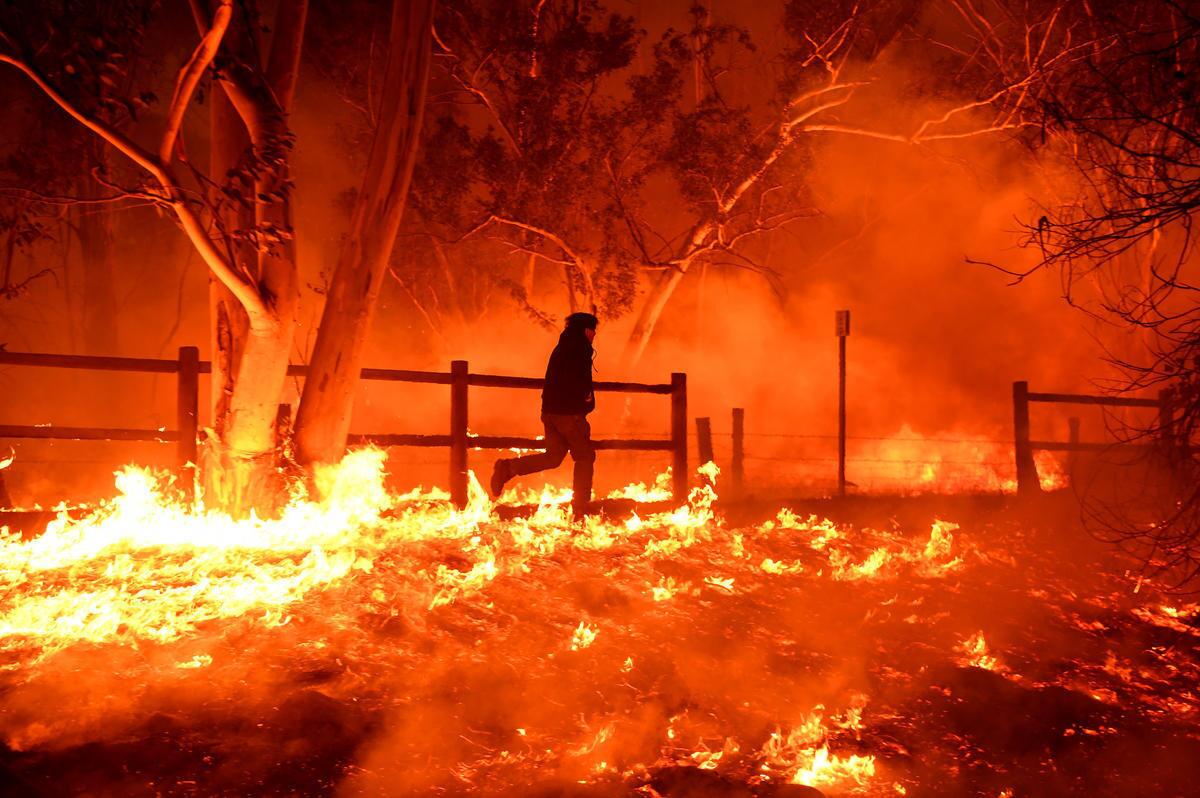
Fearing that the Thomas fire would reach their community, residents packed the Carpinteria High School gym Thursday night for a town hall with local officials.
Bleachers on both sides of the gym quickly filled for the 8 p.m. event, and residents who couldn’t find a spot on bleachers sat on the gym floor behind a row of television cameras.
Maps of the wildfire’s perimeter were taped to gym mats that hang on the wall, usually there to protect basketball players slamming into them. Signs for the Carpinteria Warriors hung on the walls.
Santa Barbara County fire officials said the Thomas fire, which has burned 115,000 acres since Monday, hadn’t reached the county line as of Thursday evening, but residents should remain prepared in case it does.
Polly Baldwin, medical director at Santa Barbara County Public Health Department, said the air quality in Carpinteria is considered “hazardous.”
“Hazardous is the worst classification that air quality has,” she said, urging residents to wear face masks when outside.
After the town hall, residents crowded around a topographical map of the region, asking fire officials questions.
The Santa Barbara County Sheriff’s Office will continue to update its website with evacuation orders and maps of the affected regions.
- Share via
Elite thoroughbred race horses killed in San Diego wildfires
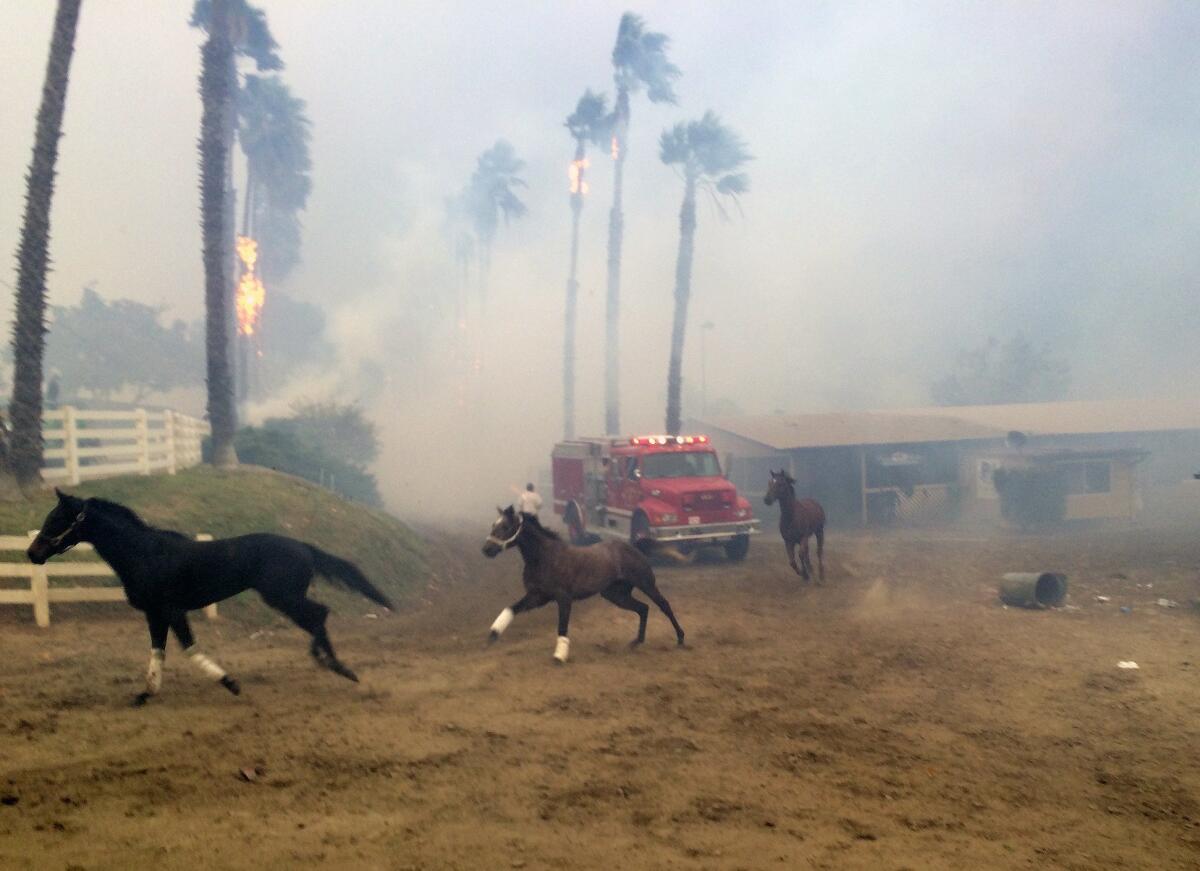
Hundreds of elite thoroughbred race horses sprinted away from flames Thursday as one of California’s major wildfires tore through a training center in San Diego County.
Not all made it.
There was no official count of how many animals were killed in the hazy confusion as both horses and humans evacuated, but trainers at San Luis Rey Downs estimated that at least a dozen had died, possibly far more.
Horses worth hundreds of thousands of dollars, which are usually carefully walked from place to place, were simply set free and encouraged to run away as flames engulfed the center near Bonsall, which is just a few miles from where the fire broke out.
Mac McBride, who was working with the center’s trainers, said it was “total pandemonium when several hundred horses were cut loose,” but he believes most of the about 450 horses stabled there survived. McBride, who works at the Del Mar race track, said some horses were evacuated to the nearby track where many compete.
“There was so much smoke it was difficult to see,” said horse trainer Dan Durham, who got his 20 horses rounded up and was loading them into vans to be evacuated. “Some of the horses were turned loose so they could be safe. They were scattered around.”
San Luis Rey Downs is home to horses that run at nearby Del Mar and other top-flight California tracks like Santa Anita Park. Doug O’Neill, whose horses have won the Kentucky Derby and Breeders’ Cup races, is among the trainers who keep at least part of their stable there.
The sign at the front calls it “Home of Azeri,” the now-retired mare who was the 2002 U.S. Horse of the Year who earned more than $4 million in her career.
Horse trainer Scott Hansen said he knows some of the 30 horses he had at the facility were killed.
“I don’t know how many are living and how many are dead,” Hansen said. “I guess I’ll have to figure that out in the morning.” For now, he said he was concentrating on getting his horses that survived to evacuation centers.
Another trainer, Cliff Sise, told KFMB-TV that he saw about 10 horses die, including his own filly.
“It was dark, everything was hot, and she wouldn’t come out. I opened the pen and tried to get behind her and get her out, and she wouldn’t get out,” Sise said. “She burned to death that quick.”
- Share via
Most residents displaced by Creek and Skirball fires will be allowed to go home
As firefighters made progress on the Creek fire, officials announced most residents will be allowed to return to their homes as of 4 p.m. Thursday.
The Riverwood, Ebey Canyon and Doane Canyon areas are open to residents only, as is the Shadow Hills area north of Sunland Boulevard, the Los Angeles Fire Department posted on Twitter. Limekiln Canyon remains closed from Pacoima Canyon Road to Maclay Street.
Skirball fire evacuees — including those who live on Roscomare Road, Bel Terrace, all roads between Sunset Boulevard and Bellagio Road, and North Casiano Road from Mulholland Drive — can return home at 8 p.m. Thursday.
As of 7 a.m. Thursday, the following evacuation zones for other Southern California fires are still in place:
Thomas fire (Ventura County)
- Ventura Avenue from Canada Larga to Foster Road
- Creek Road at Ventura Street
- Creek Road north to Camp Comfort
- Ventura Street north to Montgomery
- Creek Road south of Camp Comfort
- Persimmon Hill
- Norweign Track
- Casitas Springs
- Foster Park
- In Santa Paula, everything east of Highway 150 from Say Road to the northern city limits
- The area east of Santa Paula and north of Highway 126, including Timber Canyon Road, Toland Road and Hall Road
- Highway 150 west of Peck and north of Virginia Terrace
- Foothill, Telegraph and Ashwood Hill
- County Inn Estates mobile home park at Wells and Telegraph
- Encino Road
- Alto Road
- Feliz Road
Lilac fire (San Diego County)
- From West Lilac Road to Sullivan Middle School
- South of Burma Road
- East of Wilshire, north of North River Road
- West of South Mission Avenue
- North of Pala Road
- South of Reche Road
- West of Interstate 15
- East of Green Canyon Road
- West Mission Road
- Share via
L.A. Unified offering free meals Friday and Saturday to students affected by wildfires
Los Angeles Unified school officials are opening several centers where students affected by wildfires can pick up free meals.
Meals will be available between 11:30 a.m. and 3 p.m. on Friday and Saturday at the following locations:
- Byrd Middle School, 8501 Arleta Ave. in Sun Valley
- Reseda High School, 18230 Kittridge St. in Reseda
- Palms Middle School, 10860 Woodbine St. in Los Angeles
- Share via
A veteran mailman delivers letters to Kagel Canyon — but instead of the familiar landscape, he finds the Creek fire’s wreckage
Carlos Angulo, a U.S. Postal Service letter carrier, wound his way up and down Kagel Canyon Road, familiar by now with the neighbors — many of whom work in the film industry — who line the street.
Except on Thursday, the street was lined with charred trees, melted playground equipment and destroyed homes — casualties of the Creek fire, all.
Angulo, who has worked this route for about 13 years, pulled up outside of the ashes of one home.
He greeted the owner and another resident by name as he handed them their mail.
“I’m going to hold the mail for you in the office until you find a place or something,” Angulo told the woman, who saw her destroyed home for the first time since she evacuated.
“They’re like my family, I see them every day,” Angulo said. “It’s very sad.”
The woman who had received Angulo’s delivery was visibly shaken as she looked at what was left of her home. She declined to be interviewed by The Times.
Outside her home, another neighbor, Mathew Trippler, introduced himself and told her how sorry he was. His home, a little further down, survived.
“It [her home] went the first night?,” she asked him.
He told her he thought it had. She told him she’d woken up to red windows on Tuesday.
“I hope my cat got out,” she told Trippler.
Residents heard from the fire department that 10 homes burned in Kagel Canyon.
Although not all of the neighbors know one another’s names, they all tend to help in times of need. They hold monthly community meetings at Dexter Park and share information on a Kagel Canyon Facebook page.
Lately, the page has been filled with posts from residents trying to find ways to reach their homes, after police set a hard closure.
Wood Grigsby never left. He focused on putting out spot fires and checking on his neighbor’s properties.
He picked up his three-year-old grandson, Nathan, on Wednesday afternoon and brought him to the house where he’s lived for 10 years.
Nathan was upset that his father and grandfather did not call him to help put out the fire. Nathan, who dressed as a fire captain for Halloween last year, wants to be a fireman when he grows up.
On Wednesday, as soon as he reached the Kagel Canyon home, he grabbed his mini fire extinguisher that expels water and headed out with his grandfather to see what he could douse
Wood got his grandson the two mini extinguishers for Christmas, because he knew Nathan would quickly wear one out.
As he walked around again Thursday, Nathan pumped the extinguisher and aimed his stream of water at the ashes of a nearby home.
“I’m putting out the fire,” he told his grandfather.
“You’re putting out the fire? Good job,” he told him.
“Hey look, it’s all out now,” Nathan cried out.
Wood said, “It’s all out now.”
- Share via
Watch helicopters draw water from Lake Casitas on their way to dousing flames near Ojai
On Thursday afternoon, helicopters hauling water dipped into Lake Casitas, west of California 33, and headed to a fire near the Ojai Valley. Fires dotted the hillsides along California 150. A mix of firefighters in trucks and helicopters worked to extinguish those fires, steering them away from the towns of Casitas Springs and Oak View.
Since late Monday, the Thomas fire has burned at least 96,000 acres and 150 structures. Fire officials plan to update those numbers, possibly Thursday evening.
Through Wednesday night and into Thursday, the Thomas fire spread significantly around Ojai and into the Los Padres National Forest. Officials have feared the fire could last for weeks if the area doesn’t see any rain and if high winds continue.
- Share via
The story behind the photos: How a group of friends saved a stranger’s house in Ventura
L.A. Times photographer Marcus Yam captured dramatic photos that showed five friends fighting the Ventura blaze with garden hoses late Monday night. The photos turned into a Twitter moment and were seen by thousands of people. We talked to Marcus about how he got those shots, how to do your job in a fire, and what happened next.
Question: What was happening before these shots were taken? Where were you?
Marcus Yam: I was supposed to go to Santa Paula that night, but because of evacuation traffic, if I tried to get into the fire zone it would be too time-consuming.
- Share via
Map: New fires threaten structures in Riverside and San Diego counties

The Lilac fire, which began Thursday afternoon near the 15 Freeway and Highway 76, was threatening 1,000 structures and had grown to 500 acres by 1 p.m., according to Cal Fire San Diego.
The Liberty fire has forced evacuations in Murrieta and has grown to 220 acres, according to Cal Fire Riverside.
- Share via
Why is Southern California burning in December? A climate scientist’s answer
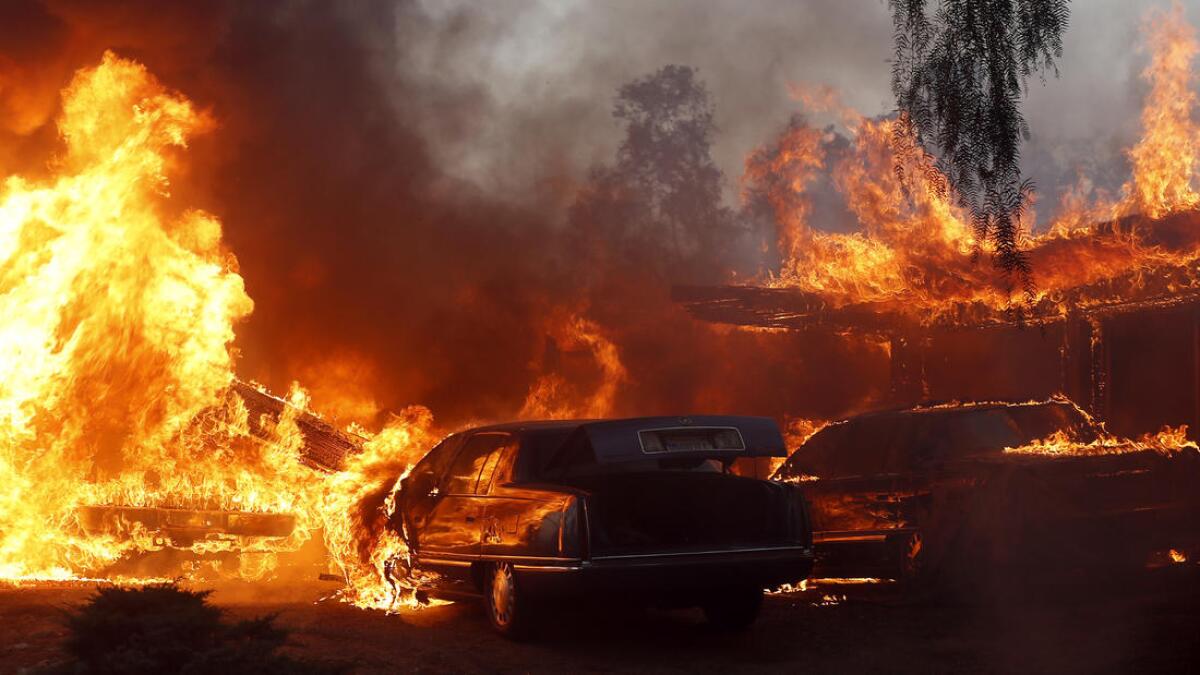
Southern California may get the Santa Ana winds every year, but — according to recorded history — they’ve never been like this.
With relative humidities in the single digits along the coastal mountains, where a series of fires has scorched thousands of acres and destroyed more than 100 homes, the air is the driest it’s been here in recorded history, said UCLA climate scientist Daniel Swain.
“The [relative] humidities right now along the coast are much drier than what you’d normally see in the interior desert in the summertime,” Swain said. “Once you get down to 1% or 2%, you’re down almost as low as is physically possible.”
It’s just a pile-on of bad news for firefighters and residents on the edge of the urban-wildland interface who are the first to get hit by wind-driven brush fires.
A layer of bone-dry, dead or dying vegetation has blanketed the Southern California landscape after a historically wet winter sprouted up green shoots that were summarily killed by the hottest summer on record. Then came October and November, which also were the hottest on record for Southern California, Swain said.
“That just even further baked the moisture out of everything,” he said.
Two months into California’s water year, rainfall is below historical averages for the season.
“Normally if we had a little bit of rain, there’s some moisture in the soil to recover,” Swain explained. “But there is no rain in sight, about as far as I can possibly say about weather.”
He added, “At least the strong winds will diminish.”
- Share via
Brush fire burning in Murrieta
Firefighters on Thursday were battling a wildfire in Murrieta that has burned more than 100 acres.
The Liberty fire broke out at Los Alamos and Liberty roads, according to CalFire.
It was not currently threatening homes.
- Share via
Near Ojai, concern about the canyon dwellers who stayed behind
Even as fiery tornadoes of flames began climbing the slopes of the remote box canyon he calls home Thursday morning, Jayson Kaufman figured he still had plenty of time to pack his valuables and head down mountain to Ojai.
To the chagrin of Ventura County sheriff’s deputies who issued a mandatory evacuation order the previous night, Kaufman was among 15 to 20 canyon dwellers who refused to leave their rustic cabins and geodesic domes tucked in dry brush.
“We’re monitoring the situation — and the clarity of the air — closely,” he said, eyeballing clouds of smoke filling the skies on both ends of the densely forested canyon. “This morning, the sky was super clear until about 10 a.m. Now, we’re playing it by ear.”
That kind of talk rankled authorities concerned about the status of the holdouts but unable to divert equipment and firefighters into the 5-mile-long canyon because Highway 33 north of Ojai was strewn with downed power lines, telephone poles and boulders.
It also worried other Matilija Canyon residents who had heeded the evacuation order but could not check the status of those who stayed behind because of failed communication networks.
“I left the canyon almost immediately after sheriff’s deputies banged on our door and told us to get out,” said Michael Kampman, 31, who was among a half-dozen people gathered at a roadblock down mountain, awaiting word of the status of their neighbors.
“I know several people who stayed behind,” he said.
The hazardous materials were removed from the road by Caltrans and utility crews about 10:30 a.m., just as winds kicked up and flames 20 feet high flared in the area about four miles north of downtown Ojai. With an estimated population of 60, and just one way in and out, Matilija Canyon has a reputation as a haven for fiercely independent mountain folk and survivalists.
By the time fire engines were rumbling up Highway 33, Kaufman watched as billowing clouds of red, orange and gray smoke rose from ridges on both sides of Ecotopia, a patchwork of sunflowers, vegetables and wildflowers he has managed for two years.
“It’s looking pretty bad out there,” he said. “But it’s still not time to leave.”
- Share via
The ‘enormous’ Thomas fire could burn for a few more weeks, fire chief says
Ventura County Fire Chief Mark Lorenzen said if the wind continues, and rain doesn’t touch the region, the Thomas fire could continue for a few more weeks.
“Until the wind stops blowing, there’s really not a lot we can do as far as controlling the perimeter, so our opportunities are hopefully going to come in tomorrow as the wind lets up,” Lorenzen said. Then, he said, the firefighters can place line around the blaze and contain part of it, but “this is a fight we’re going to be fighting probably for a couple of weeks.”
While there was once such a thing as a predictable wildfire season, Lorenzen said that season now seems to last all year — a shift, he said, potentially triggered by six years of drought and climate change.
At last count, the Thomas fire had consumed 96,000 acres, but as the fire expanded around Ojai and into the Los Padres National Forest in Santa Barbara County, that acreage will likely grow.
Fire in the forest area, Lorenzen said, presents new challenges: The dryness provides ample fuel for the fire to spread.
“There’s no road out there, and the wind is pushing it,” Lorenzen said. “You can’t put anybody out in front of it.”
This week, the fire destroyed an undetermined number of homes in Ojai.
“My hope is that within a week, the issues around the population areas are going to be gone, but then it’s still going to be up in the forest in the wilderness areas, and it’s a challenge,” Lorenzen said. “It’s hard to get [there]. The size and the scope of this thing is going to be enormous.”
Lorenzen said the public seems more apt to follow mandatory evacuation orders after the Santa Rosa fires. “We are being really, really proactive about evacuating in advance of the fire,” Lorenzen said. “So just tell people to be prepared. Be ready to go, and when the time comes, just leave.”
- Share via
As Faria Beach residents assess the danger, firefighters follow Thomas fire toward Santa Barbara County
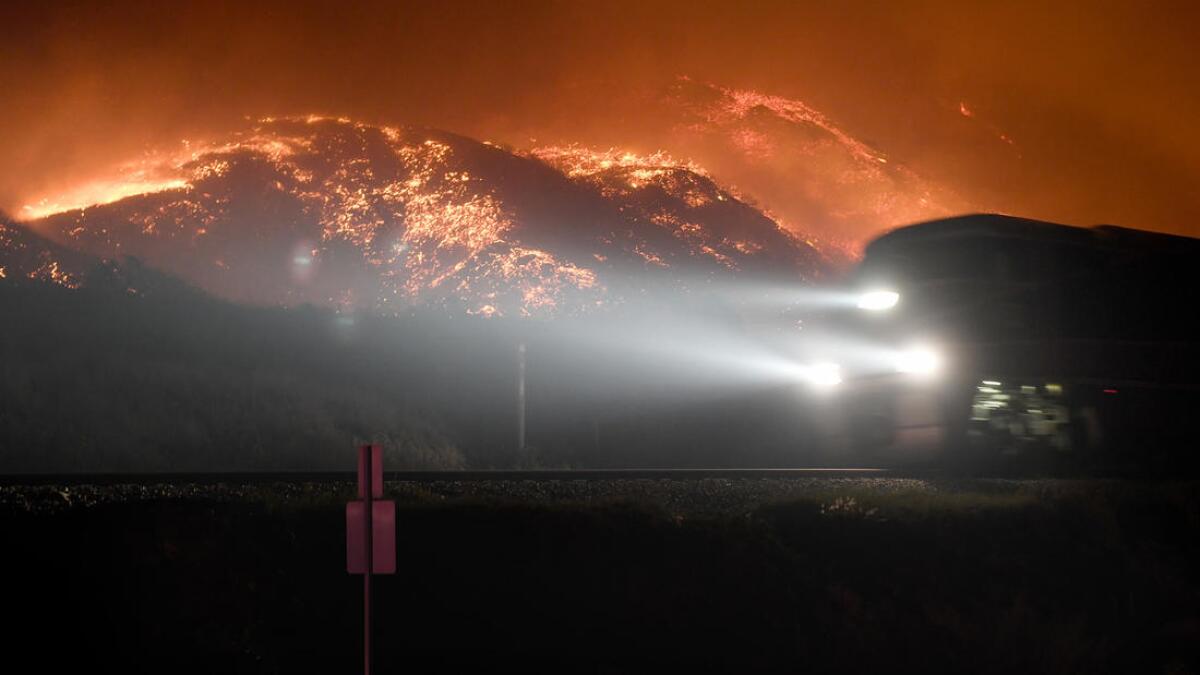
Alicia Stratton stood alongside railroad tracks in Faria Beach and watched the flames burn a few hundred feet away. She had evacuated her home about 30 minutes earlier.
Stratton, 58, lives in Oak View, but her family has a vacation home in Faria Beach.
“This fire kept migrating,” she said. “As soon as the wind picked up, I started to worry.”
Her neighbor, Charlie McDowell, was eating lunch when the fire picked up momentum in the seaside community.
“It was right in front of us,” he said, a mask and goggles covering his face. “It’s creeping.”
A few minutes later, firefighters and sheriff’s deputies asked residents along the road to move themselves and their cars away from the fire line. The flames were growing closer and the thick smoke made it hard to see.
Both said they were “very concerned” about the fate of their neighborhood.
“It’s an amazing community,” McDowell, 34, said. “I was in L.A. last night and I got a call from neighbors saying they were watering my house.”
Ventura County Fire Department spokesman Rich Macklin said firefighters are concerned that the Thomas fire will push into Santa Barbara County and threaten the city of Carpinteria.
“We’re going to start moving with it,” he said, adding that about 2,000 firefighters are battling the blaze.
Crews are concerned about erratic winds near the shore, which are reaching 30 to 40 mph, he said, with gusts of 45 to 50 mph.
As he spoke, plumes of smoke shifted toward the ocean, obscuring visibility so badly that it was difficult to see a few hundred feet ahead. Distant booms could be heard in the distance — sounds Macklin attributed to “a tank of something releasing.”
“Here, we had the fire burning toward about 70 to 80 homes,” he said. “We have six strike teams engines in there.”
The fire in Faria Beach has been knocked down, he said. Aside from the wind, crews faced serious visibility problems and were handling the additional concern of residents who waited until the last minute to leave.
- Share via
Residents west of the 405 prepare to evacuate in case winds increase
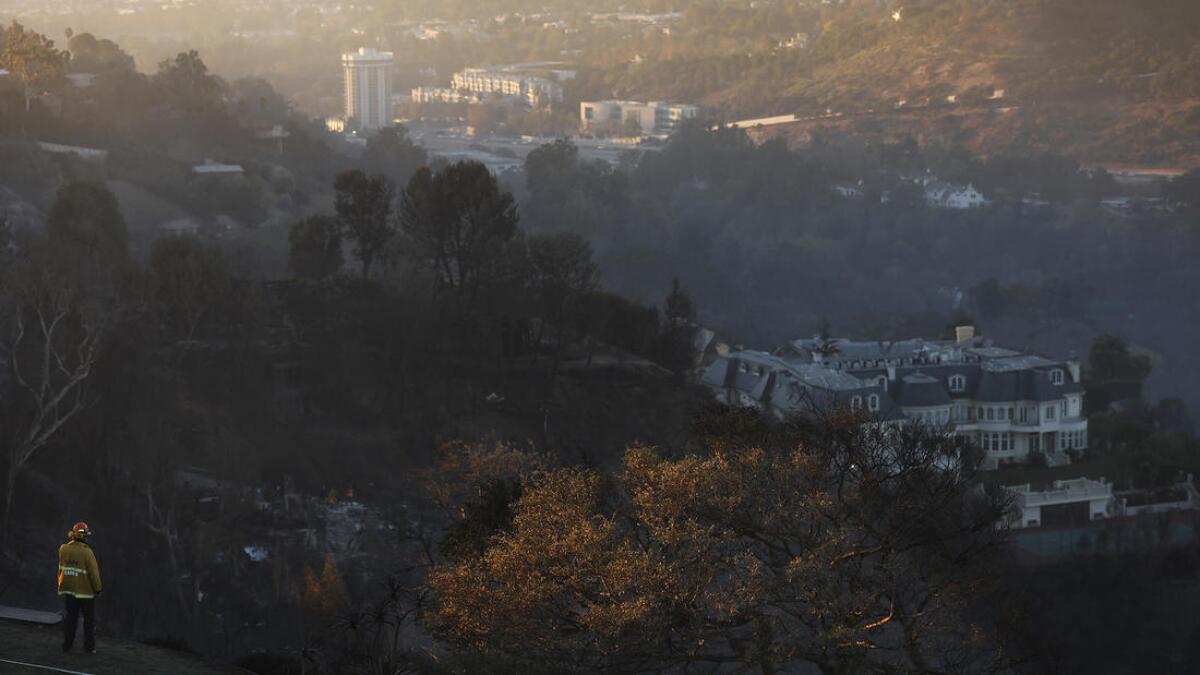
Courtney Horrow isn’t taking any chances.
She is taking her two daughters, ages 4 and 6, to Palm Desert — away from the growing winds that for days have filled the skies with smoke and ash and now threaten her home, which sits up a hill on a windy street on North Bundy Drive and Chalon Road in Brentwood.
She didn’t plan on returning to her white-wooded house until Sunday. As she placed bags of clothes in the back seat of her black SUV, she said that many of her neighbors already had chosen to evacuate.
“The winds might get stronger, and it’s blowing this direction. It’s really concerning,” she said as a gust of wind made the area smell of burned wood. “Schools are canceled, and I don’t want my children breathing in this air.”
A few minutes north of Bundy Canyon, Eric Sackler sat at home with his 9-year-old twins, Alexis and Jayson. He took the day off work to watch the kids after he found out this morning that Crossroads School in Santa Monica canceled classes for the day.
Like many of his neighbors, Sackler prepared to leave if the winds accelerated and pushed the fires across the freeway. He already has his children’s clothes and electronics packed in the car. “The TV is constantly on, and I’m monitoring the situation,” he said.
- Share via
Animated map: Watch as the Thomas fire explodes in Ventura County
- Share via
Firefighters gain toehold, contain 20% of Skirball fire by Thursday afternoon
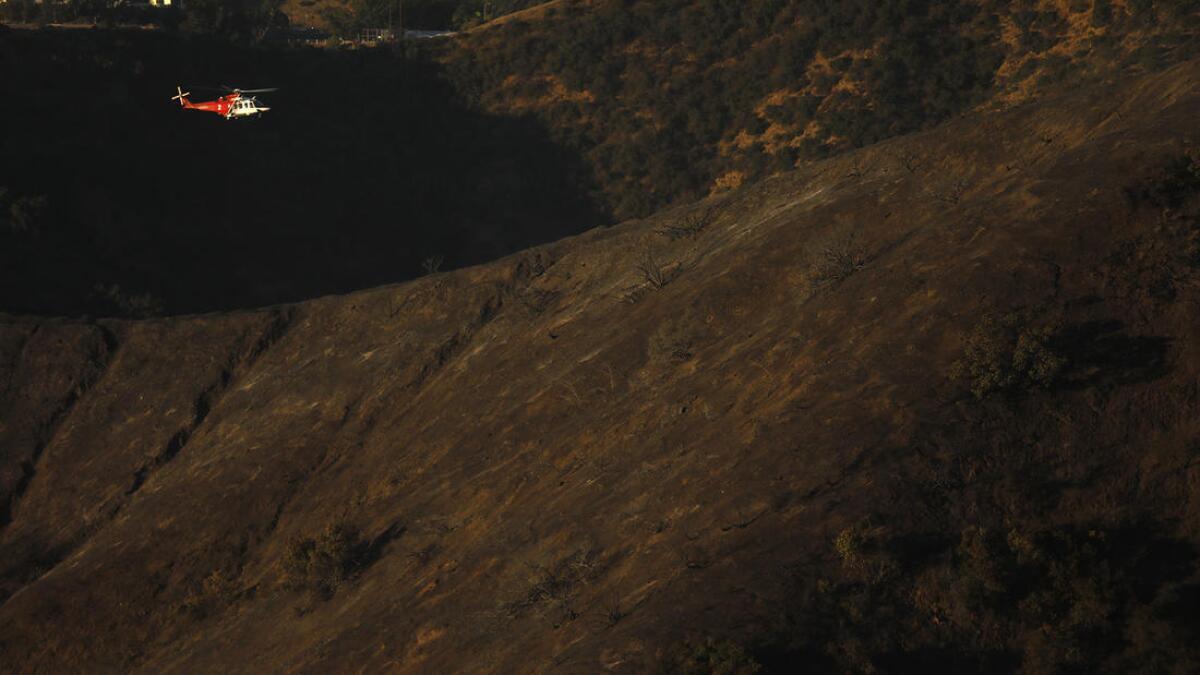
Gentler-than-expected winds Thursday morning gave firefighters a toehold against the wildfire burning in Bel-Air, which was 20% contained by 11 a.m.
The 475-acre Skirball fire has not grown in nearly a day, a testament to the overnight assault that crews launched on the western and northern edges of the fire, closest to the 405 Freeway and multimillion-dollar homes, officials said.
Despite the progress, the fight was far from over, officials said. Thursday afternoon, firefighters will face bone-dry air with a relative humidity of 4%, and 33 mph winds out of the northeast that could push the fire toward the 405.
The 20% containment figure means firefighters have cleared brush to make a fire break, or hauled in hoses, to stop the blaze from advancing along about one-fifth of the fire’s perimeter.
“We’re not done,” said Los Angeles Fire Department Chief Ralph Terrazas. “We’re in the middle of this event.”
One firefighter was injured early Wednesday and is receiving treatment for burns on his neck, Los Angeles Mayor Eric Garcetti said.
The LAFD plans to test a new technology Thursday: a drone that can use thermal imaging to seek out hot spots, a high-tech way of directing crews to areas that need attention. The drone also will assess property damage, Terrazas said. Officials used drones while battling fires in Northern California in October.
The Skirball fire has destroyed four houses on Casiano Road, Moraga Drive and Linda Flora Drive, and damaged a dozen others.
The wildfires raging across Southern California, stoked by winds as strong as 80 mph, have left fire departments stretched thin. Nearly 1,000 local agencies have sent firefighters to help battle the fires across Southern California, said Cal Fire’s Ken Pimlott.
State officials also have asked strike teams from Montana, Idaho, Utah, New Mexico and Nevada to come to California, said Mark Ghilarducci, the director of the California Governor’s Office of Emergency Services.
“Just two months ago, the city of Los Angeles had their firefighters up in Northern California fighting fires,” Ghilarducci said. “Now we’ve got Northern California firefighters here on this incident. Neighbor helping neighbor, everybody is supporting each other.”
Officials urged residents to be patient and told those who have lingered behind to leave their homes and trust firefighters to protect them.
L.A. Councilman Paul Koretz, whose district includes Bel-Air, scolded construction companies who sent their workers into the evacuation zone Thursday.
“If you are a developer in the fire zone in Bel-Air, get the hell out and don’t come back until the evacuation is over,” Koretz said. He told The Times he was concerned that the trucks and equipment could block firetruck access and potentially spark new fires.
- Share via
Despite lull, a reminder that evacuation orders are still in effect in Ojai

One of Ventura County’s most prominent politicians, former Dist. Atty. Michael Bradbury, walked into the Ojai police station Thursday, frustrated after days of living out of his car and monitoring the shifting Thomas fire.
Bradbury, wearing aviator glasses as he leaned on his cane, said he had fled to the Ventura County Fairgrounds earlier this week with about half of his horses — he sits on the fairgrounds board, after all — but wanted to return to his ranch in Ojai. The retired D.A., who held the position for more than two decades, just didn’t know where the fire was or whether the threat was still real.
City Manager Steve McClary sympathized with Bradbury’s frustration. “The problem with giving specifics of the fire: It could change in five minutes,” McClary said.
Bradbury said he understood, but later asked to speak to Police Chief James Fryhoff. The former D.A. asked the chief how the deputies were faring and pressed for details about when he may return.
“I would give it at least another day,” Fryhoff told Bradbury.
The city of Ojai has been largely spared structural damage from the fire, but some homes along Highway 33 north of the city limit have been leveled.
On Thursday, the sky south of Ojai was relatively clear and blue. To the north, where fire burned Wednesday night along the mountain ridge, the sky was gray and smoky.
Some at the city’s evacuation shelter at Nordhoff High School were growing restless as the days dragged on. Fryhoff acknowledged the cabin fever. But, he cautioned, the lull in the firefight Thursday morning — when some residents who had been evacuated had returned to their homes to see blackened hillsides but less damage than they feared — did not mean the coast was clear. Thursday night and Friday could bring more treacherous conditions.
“We’re all waiting for a wind event that we’re told is going to come,” Fryhoff said. “If we do get that, the fire could be unpredictable.”
Mandatory evacuation orders remain in effect for those north of Grand Avenue, and some sheriff’s deputies drove through the hilly neighborhood on Thursday, urging residents to heed the order despite the apparent calm.
“Hang back. We mean it,” Fryhoff said.
McClary said that once the risk abates, residents in the Ojai Valley will be told when they can return.
- Share via
Dramatic video shows firefighters combating wind and flames at Faria Beach
Firefighters battled growing, ferocious winds across the street from homes along the edge of Faria Beach in Ventura late Thursday morning.
The gusts kicked up flames on nearby palm trees and dry bushes.
A police car drove up and down the road with a megaphone blaring: “mandatory evacuation” and “please go the other way, the road is closed.”
The winds were so intense that the trees lit like matchsticks. Monstrous plumes of brown smoke billowed overhead.
Residents immediately started watering their roofs with garden hoses while firefighters kept an eye out for the beach homes nearby. Others began using water to douse trees that had caught on fire.
Maurice Shimabuku, 67, said he was saddened to see most of the palm trees across from his home had been charred. Shimabuku was among those watering their roofs to keep embers from igniting their homes, but a drop in pressure made it difficult for him to water the tree in the front.
“It was like shooting a water pistol on an elephant,” he said.
He said this was the first time he was afraid of the danger winds could potentially create in his neighborhood.
“These were some freakish winds,” he said.
The fire sent rats running for their lives.
- Share via
Residents near the Skirball fire hope winds abate, but still prepare to leave: ‘When you’re ready, you’re not scared’
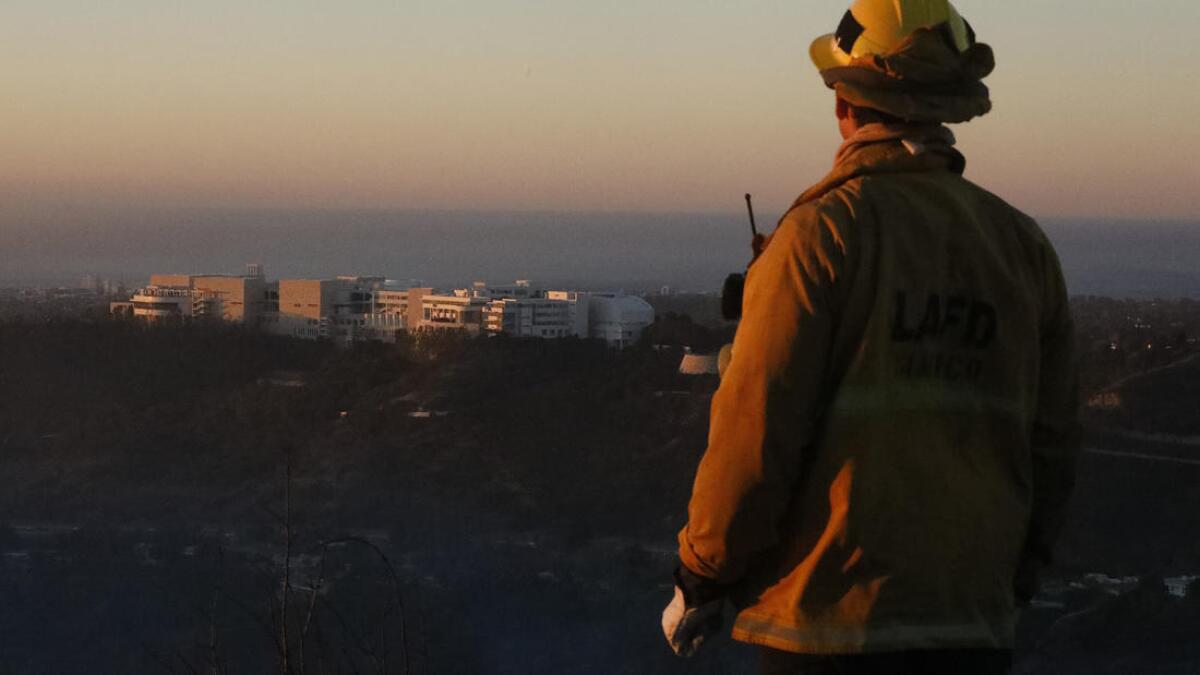
Residents west of the 405 Freeway who live near the Sepulveda Pass on Chalon Road and North Bundy Drive were cautiously optimistic Thursday morning about whether the fire would jump the freeway.
Still, many had prepared to evacuate. As a gust of wind blew dried leaves into the air, Bob Greer, 81, opened the trunk of his white Toyota.
Suitcases, photographs, documents and medication peeked out. “The one thing you cannot replace are photographs,” he said.
Greer has been living in his modest white home in Brentwood for 46 years with his wife, Ursula. They both served in the U.S. Air Force. Bob Greer retired 15 years ago.
“I’m ready to go in a minute if we need to evacuate,” he said. “When you’re ready, you’re not scared.”
His next door neighbor, Ruben Anton, has lived in the neighborhood for 20 years and doesn’t remember the last time fires have gotten this close. He pointed in front of him and behind his house. Thick patches of dried, brown brush sat on the hill directly behind his light-blue home. In front of his house and across the street, more brush lay atop the hillside. He’s worried.
Anton evacuated yesterday and spent the night at his friend’s house. He returned this morning. His car, filled with his clothes and his daughter’s paintings, is parked in his garage. “I don’t plan to evacuate unless authorities tell me,” he said. “I’m going to throw water on my roof.”
- Share via
Huntington Beach firefighters battling vegetation fire on Beach Boulevard
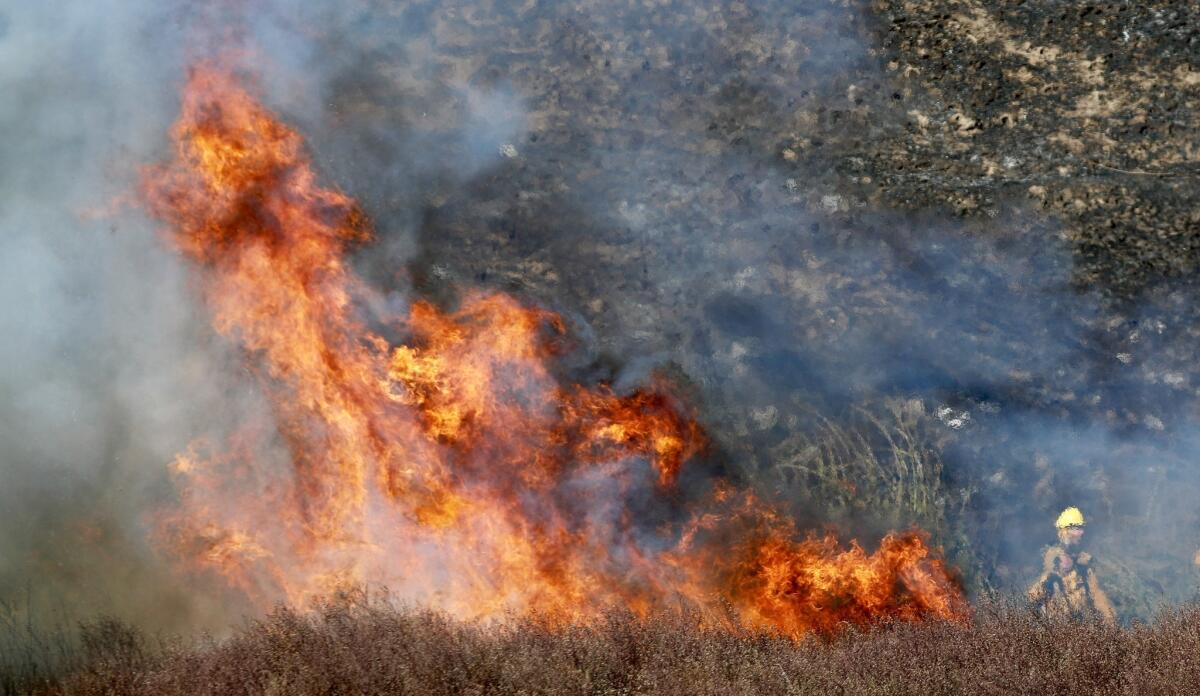
Huntington Beach firefighters were responding to a vegetation near the corner of Beach Boulevard and Adams Avenue.
Authorities urged the public to avoid the area.
- Share via
North of Ojai, residents return to destruction, loss
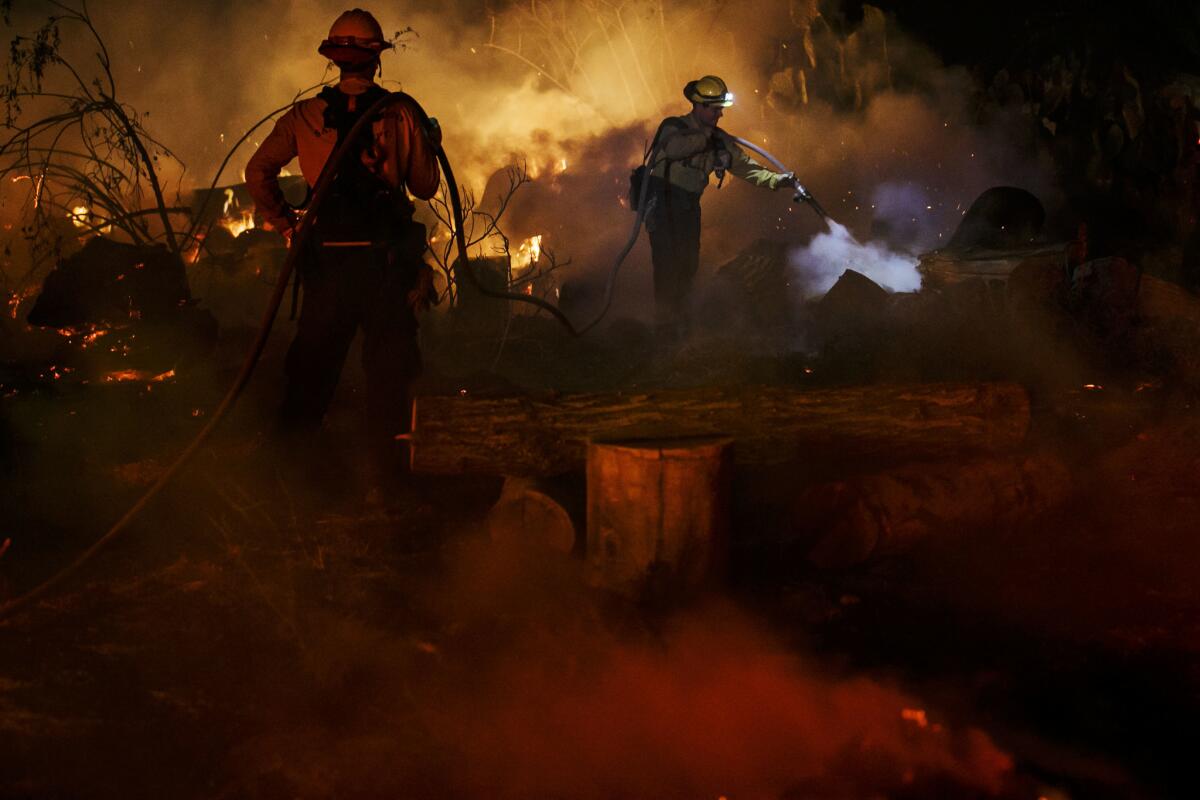
Along Highway 33, about 3 miles north of Ojai, some residents who fled late Wednesday returned Thursday morning to find their homes in ruins.
One relative of a homeowner, who declined to be identified, said her mother in law was ordered to evacuate her three-bedroom home off Camino Cielo and the Maricopa Highway. She returned to find a heap of smoldering rubble. Her family members said they were working to restore a water pump so that they could douse hot spots and soak the embers.
Other homes off Highway 33 were spared. A ranch atop a ridge at Cozy Ojai Road stood virtually untouched, with a yellow Post-It on the front door for firefighters and first responders: “we evacuated!”
- Share via
Bel-Air firefighters faced 40-mph winds overnight
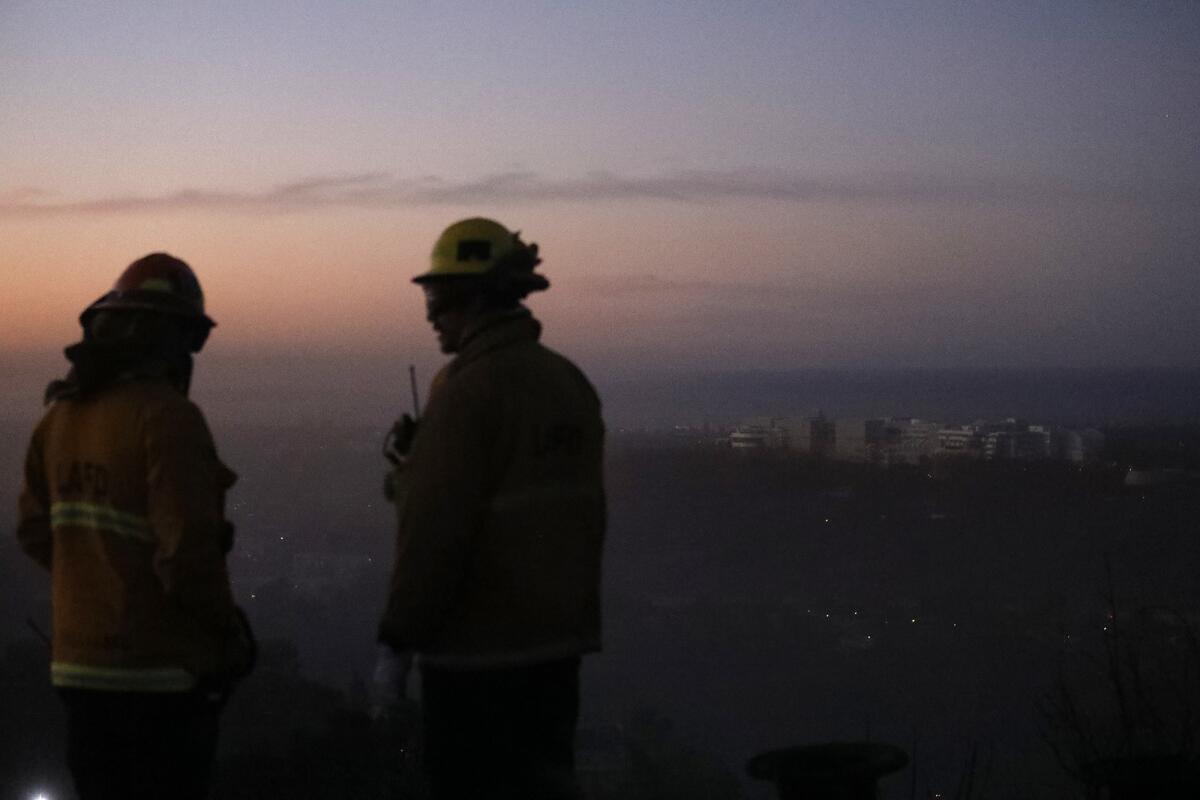
The 80-mile-per-hour winds expected in Los Angeles late Wednesday night and early Thursday morning did not materialize, giving firefighters in Bel-Air a minor reprieve as they continued to knock down flames threatening homes in one of the region’s wealthiest enclaves.
Winds reached speeds of 40 mph overnight, but the steep canyons east of the 405 Freeway worked in firefighters’ favor, sheltering the fire from the strongest gusts and preventing embers from sparking new spot fires, said Los Angeles Fire Department Assistant Chief Armando Hogan.
The Skirball fire burning just east of the 405 Freeway remained 5% contained Thursday morning and had burned 475 acres, fire officials said.
A portion of a fire perimeter is considered contained when firefighters have cleared a broad area to form a fire break, or hauled in hose lines that will stop the blaze from advancing.
The low containment number does not mean the blaze is burning out of control, Hogan said. Many of the tallest flames have been knocked down. Some active fires are still burning, Hogan said, “but nothing that is raging and roaring.”
Some deep canyons have decades of heavy brush growth that is highly flammable and is burning off, Los Angeles Fire Department spokesman David Ortiz said. Those areas are smoldering with embers that firefighters call “cat eyes,” because they glint in the darkness with a certain feline quality.
Some canyons have 70-degree inclines, too steep to accommodate firefighters at all. Fire crews are dropping water on those areas with one airplane, with another on the way, LAFD spokesman Peter Sanders said.
If the firefight goes well Thursday, with winds of 20 to 25 mph, officials may consider allowing some evacuated residents to temporarily return home to pick up clothes and medication, Hogan said.
“What we don’t want to do is pull the trigger prematurely,” Hogan said.
- Share via
Residents in La Conchita relieved to find homes still standing
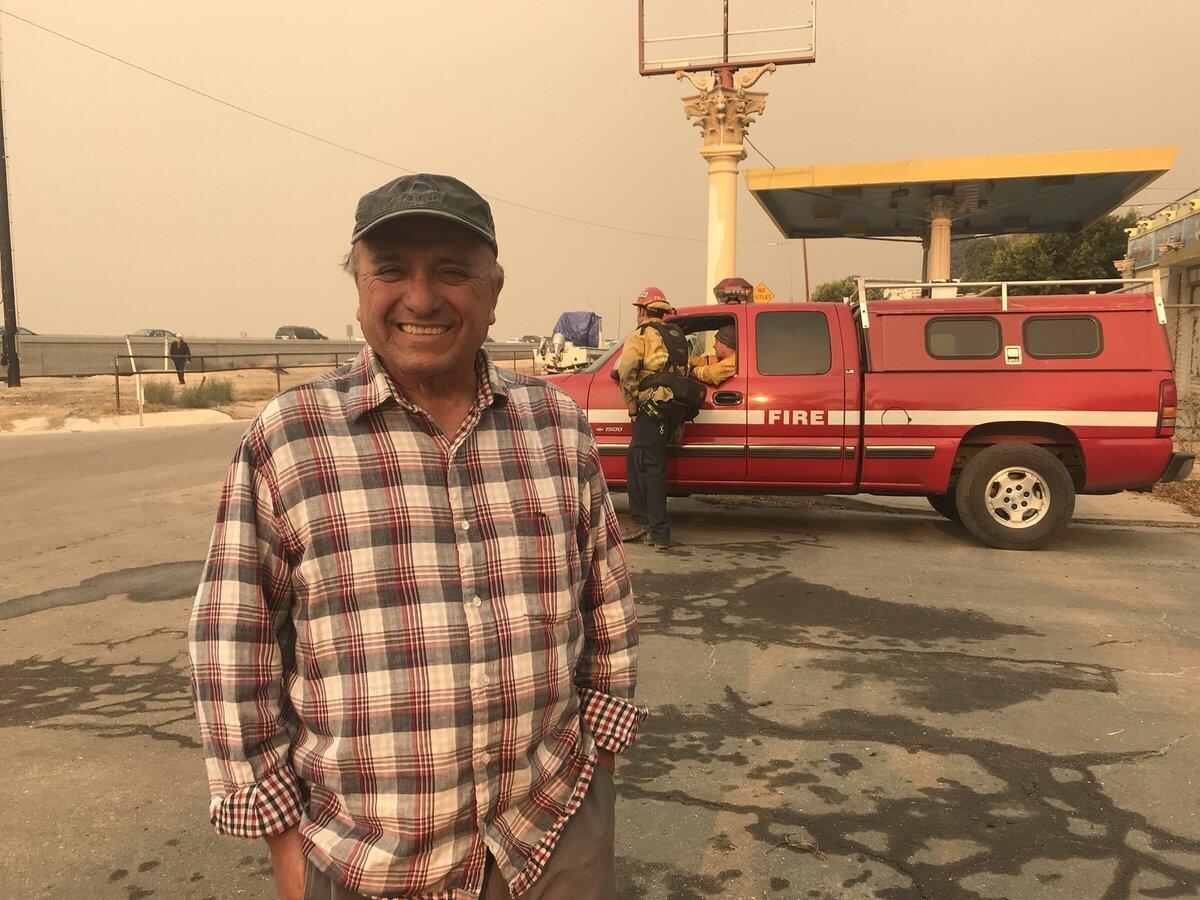
Julio Varela stood at the base of La Conchita Road and breathed a sigh of relief. While the abandoned structure just to the left of his home burned down, his house was safe.
Varela, 67, was at dinner with friends Wednesday night when he heard about the fire nearing La Conchita. All five of the friends he was with had lost their homes in Ventura.
Around 9 p.m., he made his way back to the neighborhood where he’s lived for 35 years. The police arrived shortly after and urged everyone to evacuate. But Varela stayed. He snuck into his brown house, grabbed a hose and started to water the balcony and roof, and douse any embers that flared up.
The flames, he said, sounded like a train going through the area.
“It was the most eerie thing,” he said. “And then the flames just came down.”
Varela said he was impressed with the firefighters, who quickly found a way to get water up the hill when the hydrant wasn’t working. They attached a hose to the base of the road and took a hose 100 feet up toward his home.
“It’s a relief,” he said. “I think tonight I’m gonna sleep really good.”
He called this neighborhood his “slice of paradise” and said he plans on staying here to ensure no flare-up burns his home.
“I’m going to be happy, at least for the day,” Varela said.
His wife, who spent the night at their office in Ventura, was worried that he stayed behind.
When he called her at 5 a.m. to tell her their house was OK, she cried uncontrollably.
Meanwhile, on the shoulder of the northbound 101 Freeway, Steve Holmstrom tried to catch a glimpse of his home.
“I left last night because it was getting too close,” he said, adding that his spent the night with his children in Carpinteria.
The abandoned structure next to his house burned down Wednesday night, he said. The 62-year-old, who lives on Fillmore Avenue, said he was worried because his home is made of wood.
“Thankfully they saved it,” he said.
Holmstrom said he’s lived in this area since 1972, and his house survived other disasters, including a devastating mudslide that killed residents at the base of the hill.
“These firefighters are amazing. This whole place could’ve gone,” he said. “I feel so much better. Last night was kind of a panic.”
- Share via
New Malibu brush fire that threatened homes is contained
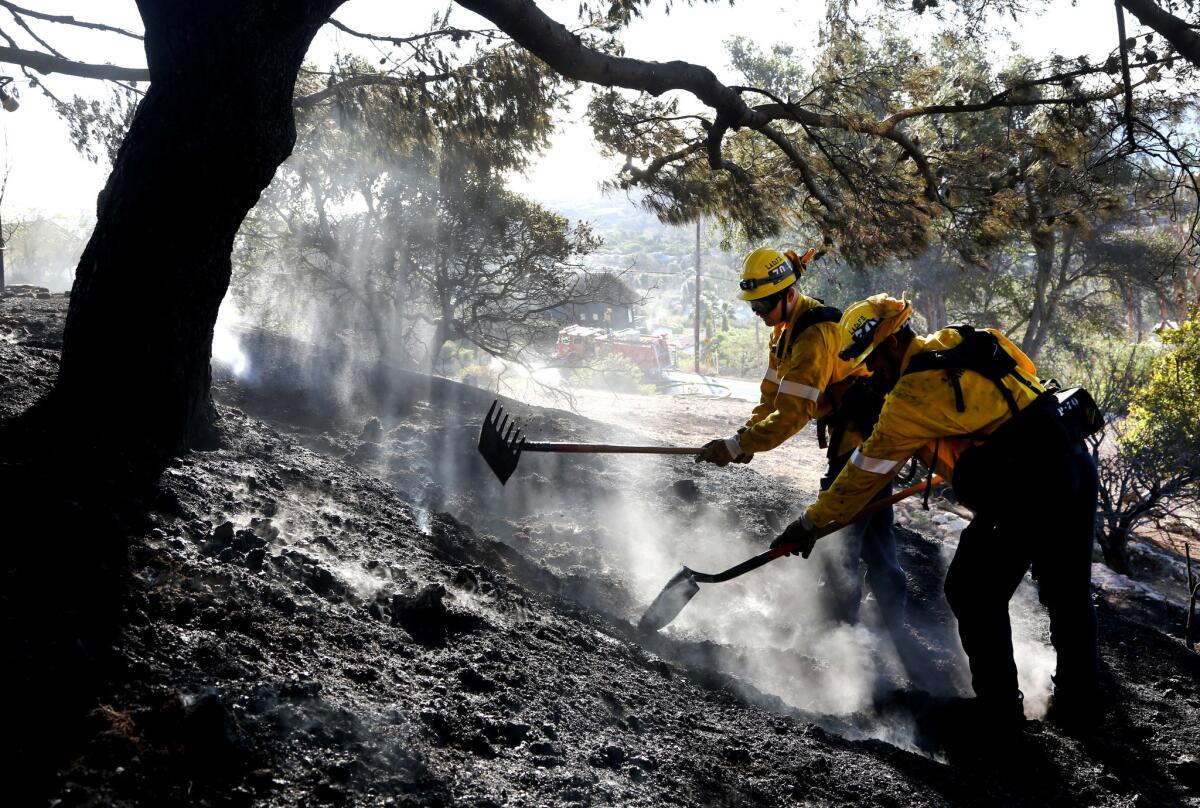
A brush fire broke out Thursday morning in Malibu, but firefighters were able to contain it before it struck homes.
The brush fire broke out in the 5300 block of Horizon Drive in the hills on the northern end of the city.
The fire was burning amid a cluster of homes in a canyon. The Los Angeles County Fire Department sent firefighters and a chopper to the scene. Some residents also used garden hoses to fight the fire.
- Share via
Residents help extinguish spot fires near Faria Beach
- Share via
Early morning view from Skirball fire
- Share via
Motorists on the 101 Freeway in Ventura County are driving into a wall of smoke
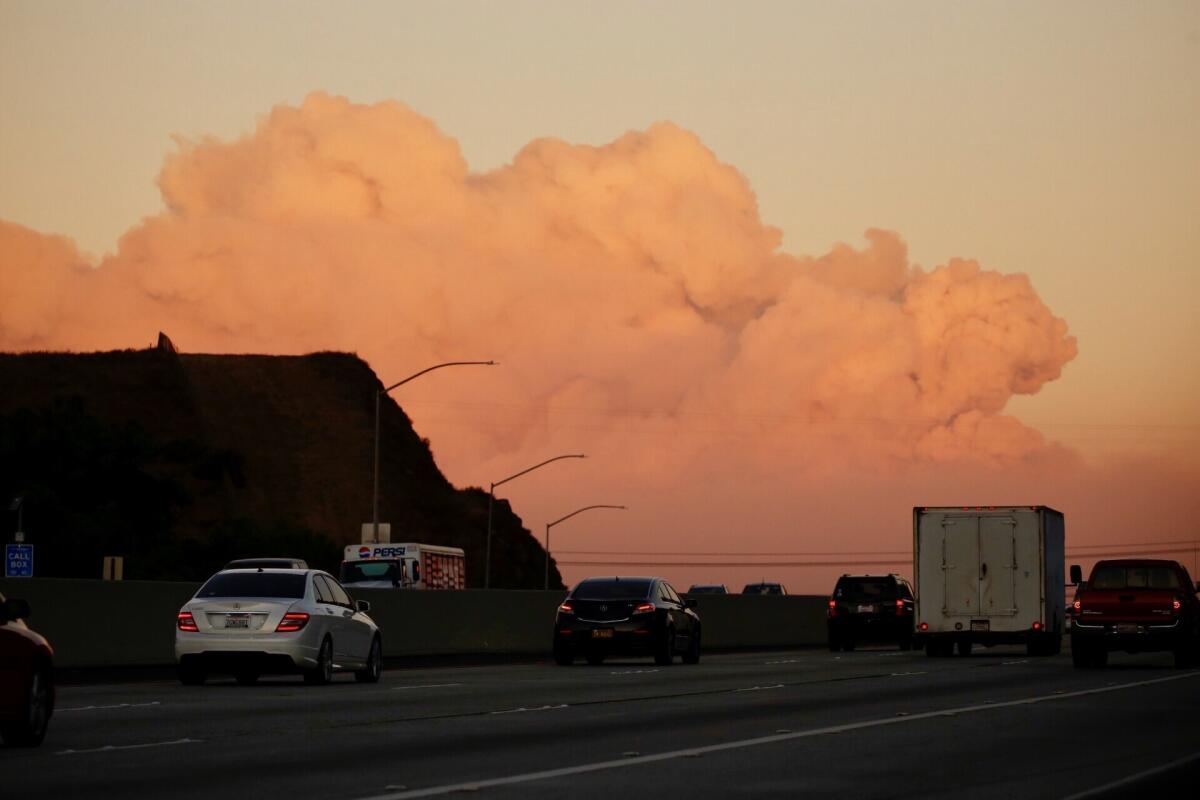
- Share via
Raw video: Thomas fire burns through La Conchita

Raw video: Thomas fire burns through La Conchita
- Share via
Video shows man trying to save rabbit from Ventura fire
This video is getting a lot of attention.
It shows a man saving a wild rabbit that was running toward the flames of the Thomas Fire in Ventura County.
The man was not identified. But he has a lot of fans this morning.
KABC-TV said the scene was captured on Highway 1 near La Conchita. on Wednesday night.
- Share via
LAPD urges drivers to avoid shortcuts from navigation apps in fire zones
The Los Angeles Police Department asked drivers to avoid navigation apps, which are steering users onto more open routes — in this case, streets in the neighborhoods that are on fire.
Following officers’ directions and obeying the roadblocks “will help us, and it will help L.A. City Fire,” said LAPD Cmdr. Blake Chow.
Large swaths of Bel-Air as well as parts of Lake View Terrace and Sylmar have been evacuated due to fires in those areas.
- Share via
Avoid outdoor physical exertion because of bad air from fires, health officials say
Smoke from four wildfires raging across Southern California has resulted in unhealthy air quality across the San Fernando Valley, along with coastal areas and surrounding portions of Los Angeles County.
All people in those areas should avoid unnecessary outdoor exposure and limit all physical exertion, said Dr. Jeffrey Gunzenhauser, the county’s interim health officer.
“It is difficult to tell where ash or soot from a fire will go, or how winds will affect the level of dust particles in the air, so we ask all individuals to be aware of their immediate environment and take actions to safeguard their health,” Gunzenhauser said.
“Smoke and ash can be harmful,’’ Gunzenhauser said, especially for vulnerable individuals, such as the elderly, children, people with asthma or individuals with other respiratory or heart conditions.
Throughout the county, sensitive individuals should stay indoors as much as possible -- even in areas where smoke, soot, or ash cannot be seen or there is no odor of smoke, Gunzenhauser said.
“We are also advising schools that are in session in smoke-impacted areas to suspend outside physical activities, including physical education and after-school sports, until conditions improve,’’ Gunzenhauser said.
- Share via
Bel-Air fire: 4 homes destroyed, 475 acres burned
The Skirball fire is 5% contained after burning 475 acres, destroying at least four homes and damaging other structures in Bel-Air, according to an update released Thursday morning.
The fire prompted a mass evacuation of the upscale neighborhood and closed the 405 Freeway for several hours.
The Los Angeles Fire Department said it remains on the scene trying to contain the fire.
- Share via
Cal State Northridge cancels classes amid fires, winds
Cal State Northridge cancelled classes today amid the high winds and growing fire danger.
The campus is several miles west of the Creek Fire zone. That fire destroyed at least 30 homes and burned 12,000 acres.
In anticipation of the heavy winds, all Los Angeles Unified schools in the San Fernando Valley as well as 17 schools on the city’s Westside will be closed for the rest of the week, district officials said Wednesday afternoon.
The decision closes at least 265 schools in neighborhoods affected by the wildfires raging in and near Los Angeles.
Here is the CSUN statement:
CSUN campus is closed and classes have been canceled for Thursday, December 7. High winds and smoke from the fires in and around the San Fernando Valley have affected air quality on campus and traffic conditions. University officials are closely monitoring the situation and will post updates as necessary.
Students, faculty and staff should not come to campus Thursday. Students should consult with their instructor if they have questions regarding their coursework. Employees scheduled to work this day will be granted administrative leave (with no deduction to personal hours accrued) due to the campus closure.
- Share via
Firefighters at mercy of Santa Ana winds as fire siege enters third day
Q: So what is the forecast?
A red-flag warning has been extended through Saturday across much of Southern California as firefighters struggle to get a handle on several wildfires raging across the region.
The warning, which indicates extreme fire danger because of gusty winds and low humidity, will be in effect through Saturday in Los Angeles and Ventura counties, where fires have scorched more than 80,000 acres and destroyed many homes.
Weather officials expect winds to pick up through Thursday, bringing “damaging” gusts of 50 to 70 mph that could knock down trees and power lines, and cause fire to spread rapidly. They also warned of isolated gusts of up to 80 mph in the mountains.
Winds will gradually weaken Friday and Saturday, officials said.
Q: Why are the the winds such a factor for firefighters?
Powerful winds can push existing fires but also help fan new ones.
“We are in the beginning of a protracted wind event,” said Ken Pimlott, director of the California Department of Forestry and Fire Protection.
“There will be no ability to fight fire in these kinds of winds,” Pimlott said. “At the end of the day, we need everyone in the public to listen and pay attention. This is not ‘watch the news and go about your day.’ This is pay attention minute by minute … keep your head on a swivel.”
Q: How do high winds affect the firefight?
When the Thomas fire broke out Monday evening, the winds were so strong that water-dropping aircraft were grounded and firefighters on the ground could not keep pace with the flames.
Those conditions continued through much of Tuesday, as the fire swept through neighborhoods in Ventura, destroying hundreds of homes.
The firefight improved as winds calmed, allowing officials to do battle in the air and on the ground when the fire was moving slower.
But even Wednesday, the size of the fire in Ventura County continued to grow.
- Share via
New evacuations as Ventura fire spreads rapidly
The Ventura fire continued to spread Thursday morning amid high winds, forcing new evacuations along the coast and inland. Here is the latest evacuation list:
City of Santa Paula - Boundary of Say Road north to Thomas Aquinas, Dickenson Ranch Road east to Santa Paula Creek
Santa Paula unincorporated area, east of Santa Paula Creek, north of California 126, west of Hall Road to Timber Canyon Road
City of Santa Paula - Boundary of Monte Vista Street north to city limits, Foothill Road from Steckel to Peck Road to north of city limits
Santa Paula unincorporated area towards Ventura - North of Foothill Road from Peck Road to Wells Road, including Wheeler Canyon, Aliso Canyon and Rancho Vista
City of Ventura - Teloma east to Brent Street, Telegraph Road north to, north of Foothill Road
City of Ventura - Victoria Road east to Hill Road, Telegraph Road north to Foothill Road
City of Ventura - North Ashwood Avenue east to Hill Road, Telegraph Road north to Foothill Road
City of Ventura - North of Foothill Road from Wells Road to Poli Street
City of Ventura - North of Main Street from Seward Avenue to California 33 (includes entire Ventura Avenue area)
Oak View - Boundary of California 33, Creek Road and Hermosa Road
Meiners Oaks - North of E. El Roblar between Rice Road and California 33
Entire Community of Casitas Springs - Evacuate to Ventura County Fairgrounds, 10 West Harbor Blvd., Ventura
East Ojai Valley - Carne Road east to McAndrew Road, Reeves Road north to Thacher Road
Ojai - North of Grand Ave east of Mercer Avenue west of Carne Road and south of the Gridley Trail
Upper Ojai Valley - California 150 from Dennison Grade east to Osborne Road and all residences north
Upper Ojai Valley (West) - California 33 - Matilija Canyon
Ventura County North Coast Area - Boundary of California 33 on the north to Casitas Vista Road, northwest to California 150, California 150 (Casitas Pass Road) west to U.S. 101 and south on U.S. 101 (including Pacific Coast Highway) to Emma Wood State Beach
- Share via
Fire burns across 101 Freeway; all routes between Ventura and Santa Barbara closed
Communities both on the coast and inland were under threat from the Thomas fire. At 4 a.m., officials closed the 101 Freeway between Routes 126 and 150. According to the California Highway Patrol, that left no open routes between Santa Barbara and Ventura counties.
The Thomas fire has scorched about 90,000 acres and carved a path of destruction that stretches more than 10 miles from Santa Paula to the Pacific Ocean.
As flames raged toward neighborhoods in Ojai, Carpinteria and Fillmore, officials issued new evacuation orders in Ojai Valley, notifying residents with an emergency cellphone alert. Authorities said they were helping residents of five assisted-living facilities evacuate, while people at Ojai Hospital were advised to shelter in place.
- Share via
UCLA students dissatisfied with the university’s response to Skirball fire
UCLA students are expressing their unhappiness with the way the university’s administration has handled communications about the Skirball fire at a time when students are preparing for final exams.
The Undergraduate Students Assn. Council and Graduate Students Assn. started a petition that has been signed by more than 10,000 individuals and will be sent to administrators Thursday.
Wednesday was “a day of great anxiety, tumult and stress for us all. Despite fearing for our safety, we were left in a state of constant limbo by the University, its staff and faculty,” the petition states. “Students were expected to decide between fulfilling academic and employment responsibilities and putting themselves in harm’s way — a decision no student should ever have to make.”
The petition argues that the university waited too long to cancel classes and called for administrators to review emergency management procedures.
- Share via
Are you ready for a last-minute evacuation in case of fire? Here’s how to prepare
As four major fires burn throughout Southern California, many residents face mandatory evacuations.
The brush fires move quickly. A small flame can grow out of control in 30 seconds, and temperatures can reach 600 degrees at eye level, according to Ready LA, a city website for emergency preparedness.
In a rush, some choose to grab sentimental objects, such as medals and photographs. But what should you be gathering ahead of time to be prepared if you must evacuate?
The basic disaster supply kit should include nonperishable foods and one gallon of water a day for at least three days, a first aid kit, flashlights, prescription medication, a change of clothing, sanitation supplies, cellphone chargers and other basics.
Pack similar items for your pets. Put smaller animals in carriers and be sure dogs and cats have collars and tags.
Documents such as insurance policies, identification cards and bank account records should be carried in waterproof, portable containers or saved electronically, according to Ready.gov, a federal emergency preparedness website.
Before you leave, windows and doors should be locked and flammable window shades and curtains should be removed, according to the California Department of Forestry and Fire Protection. Air conditioning and gas should be shut off, but lights should be left on so firefighters can see the house in smoke. Cal Fire also recommends moving flammable furniture to the center of the room, away from doors and windows.
Evacuees should plan at least two evacuation routes in case major roads or highways close as well as several places to take shelter, such as a friend’s home or a motel. Since most public shelters only allow service animals, pet owners should also find temporary shelters for their pets.
Below is a list of additional supplies that should be included in basic emergency kits or can be useful in emergency events:
- Non-prescription medications
- Glasses and contact lense solution
- Pads, tampons and other feminine hygiene items
- Extra water and food for pets
- Matches in a waterproof container
- Paper cups, plates, towels and utensils
- Pencil and paper
- Chlorine bleach and medicine dropper to disinfect water
- Moist towelettes, garbage bags and plastic ties for sanitation
- Wrench or pliers to turn off utilities
- Local maps
- Can opener
- Share via
Fire-related power outages leave Ventura residents scrambling
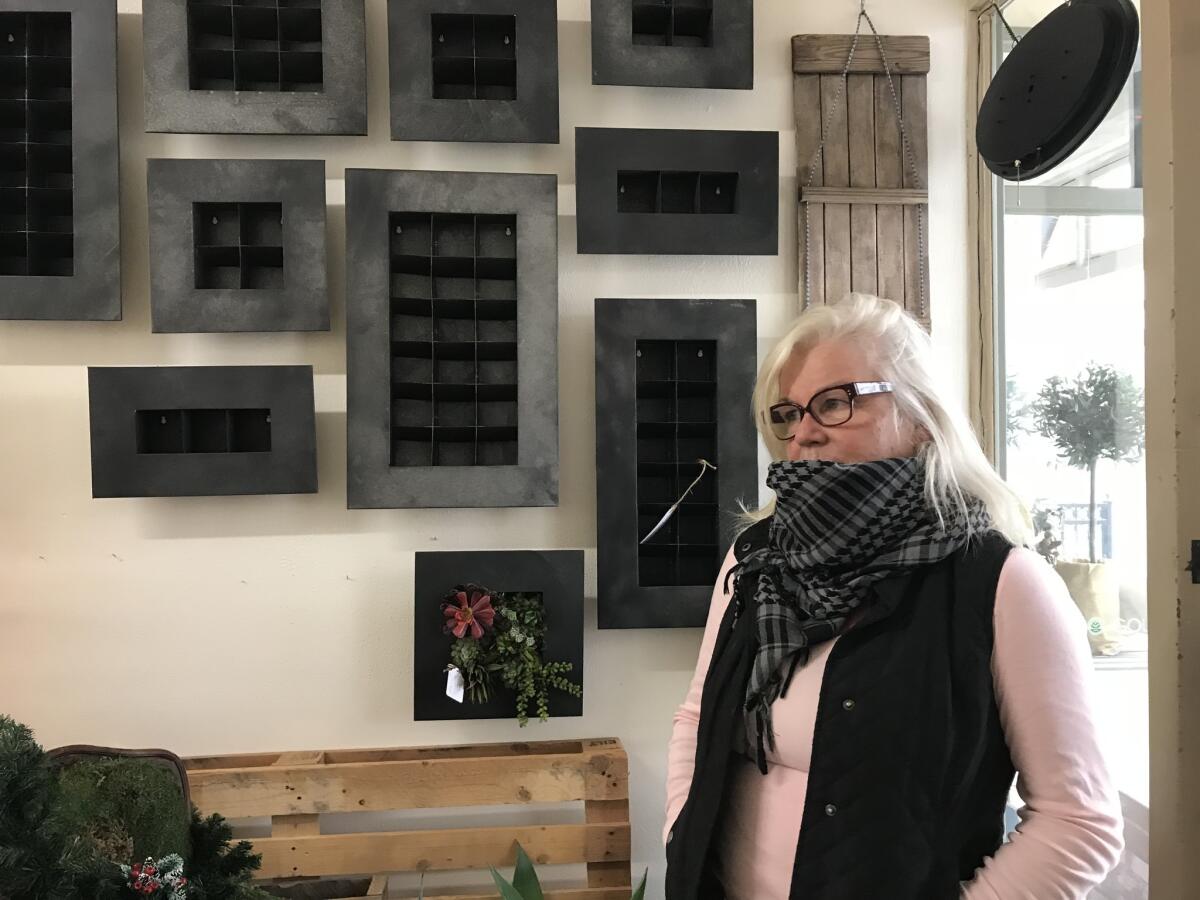
Carole Nolte, owner of Co.min.gle, a novelty shop on Main Street in Ventura, took refuge in her store Wednesday afternoon so she could charge her smartphone. She wasn’t open for business but took advantage of working electricity in her shop.
Her condo, a two-minute walk away, has been without power since Monday night, a couple of hours before she was forced to evacuate because of the Thomas fire. The blaze came within about 200 feet of her home, but the condo was left unscathed.
Since then, Nolte has been waiting for the electricity to be restored to her home. She’s unsure when that will be but is trying to make the most of it until then.
“I’m kind of sticking it out,” she said.
Nolte planned to hold a dinner party at her store Wednesday for 10 of her friends in the same condominium complex. All were left without electricity and have become something of a support group for one another, she said. Nolte’s store has a working refrigerator, so that’s where she intends to store the food for the dinner.
Tuesday evening, the group of friends barbecued whatever food they could find. Nolte scoured a supermarket in town that also was without electricity, scoring still-cold rib-eye steaks.
Wednesday afternoon, she unloaded bottles of water and coffee from her vehicle and placed them on the floor next to a Christmas tree and other holiday trinkets. She turned on a floor fan facing the door in an attempt to keep the smoke outside and away from her rugs and upholstered furniture inside. She opened the store just three months ago.
The smoke wasn’t so bad earlier in the week. Wednesday was different.
“It’s going to be a mask day,” she told herself when she woke up Wednesday morning.
If the power doesn’t come back and the air quality remains the same, she may just leave the store and stay with family in Westlake Village.
“There’s nothing to do here but breathe bad air,” Nolte said.
- Share via
The Creek fire left Wildlife Waystation staffers working in the dark with lions, chimpanzees and bison
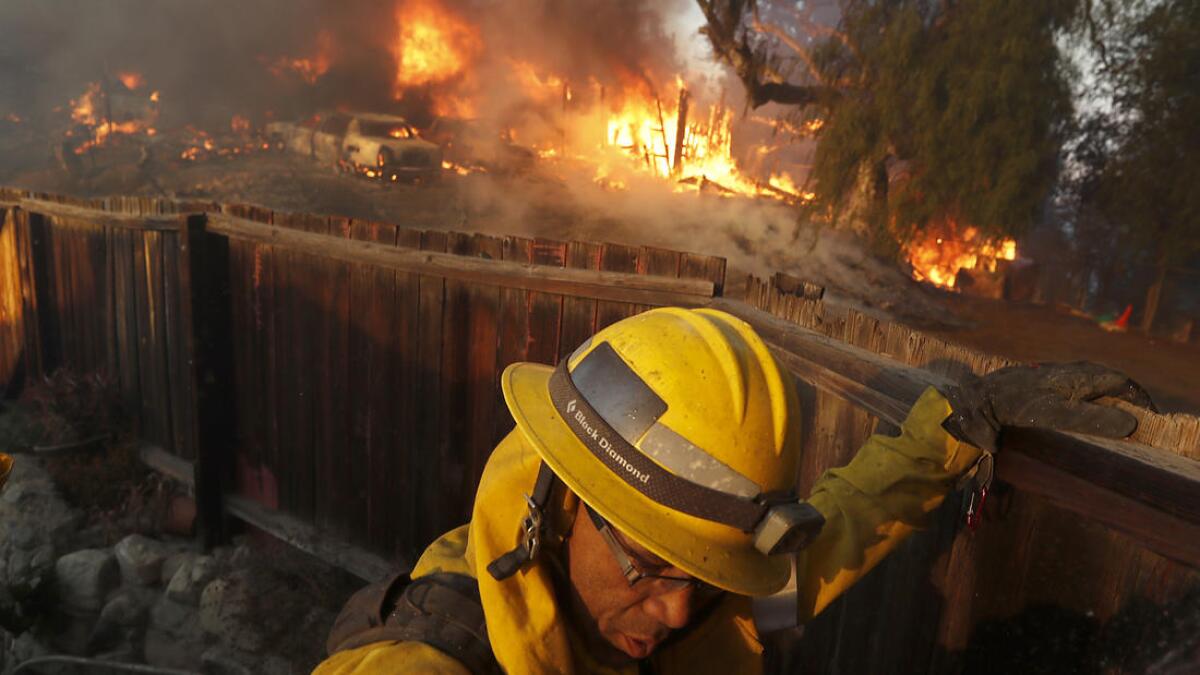
On Little Tujunga Canyon Road at the Wildlife Waystation, staff members worked on little sleep to keep the wild and exotic animal sanctuary — and its residents — safe.
Martine Colette, founder of the Wildlife Waystation, kept her walkie-talkie close while she worked Wednesday, as firetrucks rolled in and out of the parking lot. Smoke billowed from the mountains nearby, sending ash through the air. Firefighters continued to put out spot fires throughout Wednesday.
Colette, who lives in a home at the center of the facility, woke up at 4:30 a.m. Tuesday to see the fire blazing nearby. She and her staff immediately began working to ensure the animals didn’t burn in their enclosures.
Once dawn came, they began preparing for evacuation. They separated the different types of caging, some suitable for hyenas, others for Siberian tigers, another suitable for a chimpanzee. They had to figure out what to do about the buffalo roaming loose in the fire zone, as well as what they’d do with animals with small lungs — like birds — who wouldn’t be able to survive the smoke.
“The smoke was very thick,” Colette said. “It was very, very scary.”
The power went out early Tuesday evening.
“You’re now working in the dark and you’re working with very dangerous animals. You’re working with lions and tigers and leopards and hyenas and mountain lions, things like that,” she said. Staff worked by flashlight.
“I have the greatest staff anybody could possibly want,” she said.
Some of the animals were evacuated to a zoo and others to motion picture compounds — facilities capable of dealing with them. Of 350 to 400 animals usually housed at Wildlife Waystation, 100 were not evacuated.
Early Wednesday, the fire kicked off again.
“Out of nowhere, this huge inferno exploded,” she said. “It felt like you were in the middle of hell with everything burning around you.”
The fire burned a portion of the property, but there has not been a loss of animal life, as far as Colette knows right now.
Colette founded the Wildlife Waystation in 1976. It relies on donations and memberships to raise the 2.5 to 3 million needed every year to continue operating.
They estimate the cost of damage and of evacuating the animals as being easily in the tens of thousands of dollars.
“We truly appreciate any gift through this very difficult time,” Colette said.
- Share via
Fires close 265 L.A. Unified schools for the week; Santa Monica-Malibu closures continue
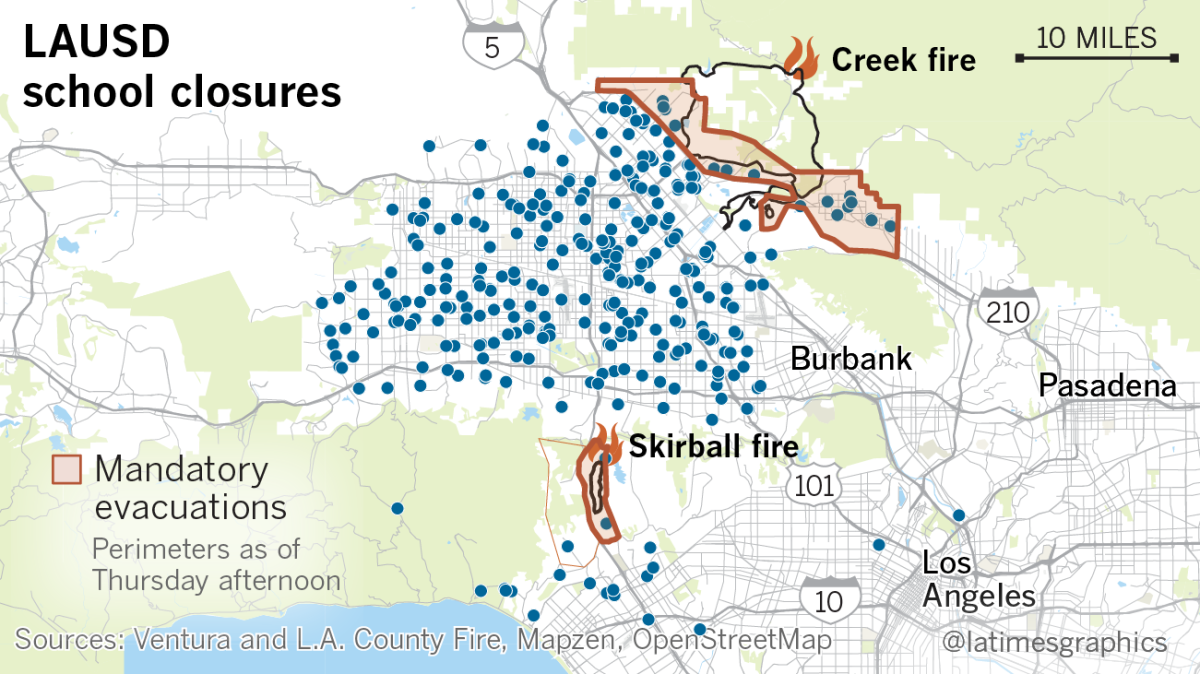
All Los Angeles Unified schools in the San Fernando Valley as well as 17 schools on the city’s Westside will be closed for the rest of the week, district officials announced Wednesday afternoon.
The decision closes 265 schools in neighborhoods affected by the wildfires raging in and near Los Angeles.
The district’s website has a full list, as well as a reminder that everyone else is still expected to come to school this Thursday and Friday.
On Wednesday, more than 50 L.A. Unified schools were shuttered.
The Santa Monica-Malibu Unified School District will keep all of its 16 schools closed Thursday. Officials made that decision “predominantly based on the expected high winds and the ongoing fires in our area, and the air quality,” said spokeswoman Gail Pinsker. As of Wednesday afternoon, the district planned to open schools Friday, but it will make a final determination Thursday.
- Share via
Before-and-after images of the devastating fires in Southern California
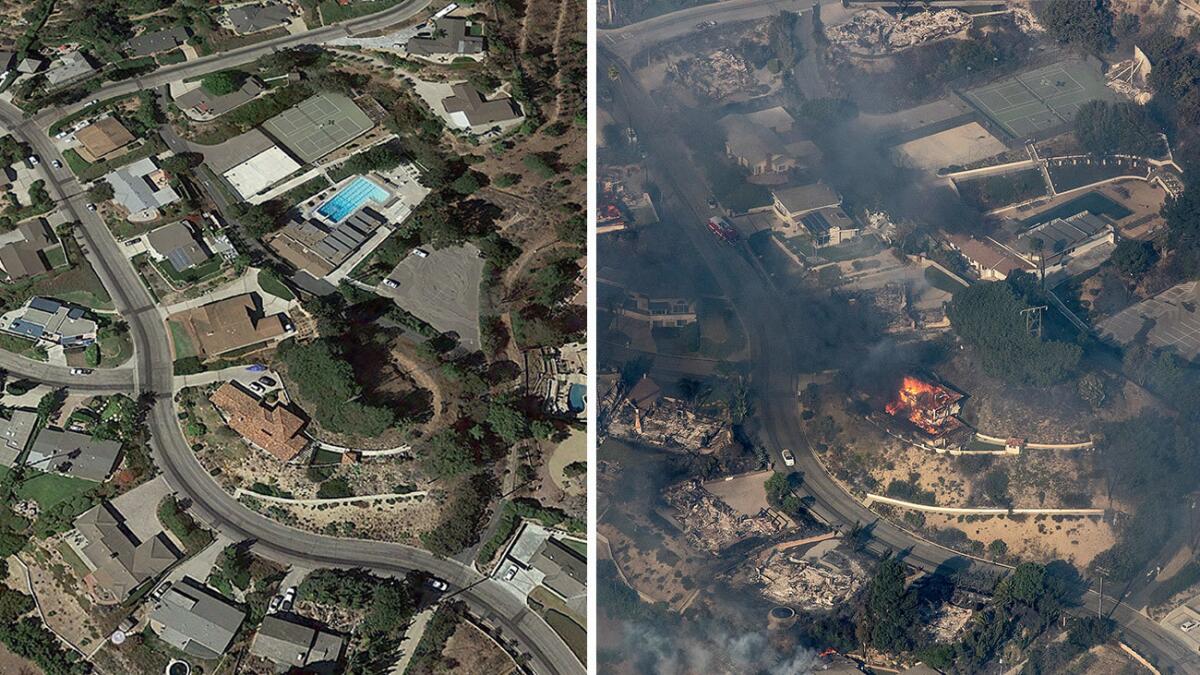
A series of Santa-Ana-wind-driven wildfires raging across Southern California have destroyed at least 180 structures, forcing thousands to flee and filling the region with smoke. Much of the reported structural damage has been in Ventura County, where the Thomas fire has already burned 65,000 acres. The fire jumped the 101 Freeway the evening of Dec. 5, threatening coastal towns. Here’s where some of the damage has occurred so far.
- Share via
Firefighters attempt to contain Bel-Air blaze ahead of the strong winds expected Thursday night
Firefighters scrambled Wednesday afternoon to make progress against the Skirball fire burning in Bel-Air before the return of strong winds that could blow the fire across the 405 Freeway.
The blaze had grown to 475 acres and was 5% contained by 3 p.m. Helicopters and fixed-wing aircraft dropped retardant on the flames, while engine companies and hand crews worked to establish a line on the southern and western edges of the fire, near the 405.
“It’s critically important we get some containment” before the winds return, said Los Angeles Fire Department Deputy Chief Chuck Butler. “When the winds come up, they’re going to come out of the northeast, and they’re going to want to push the fire across the 405 Freeway.”
Officials urged residents in the mandatory evacuation area to leave and suggested that residents west of the freeway begin packing and forming a plan for where to go if evacuations became necessary.
The Los Angeles Police Department asked drivers to avoid navigation apps, which are steering users onto more open routes — in this case, streets in the neighborhoods that are on fire.
Following officers’ directions and obeying the roadblocks “will help us, and it will help L.A. City Fire,” said LAPD Cmdr. Blake Chow.
- Share via
Ventura residents return to retrieve their essentials, but find devastation
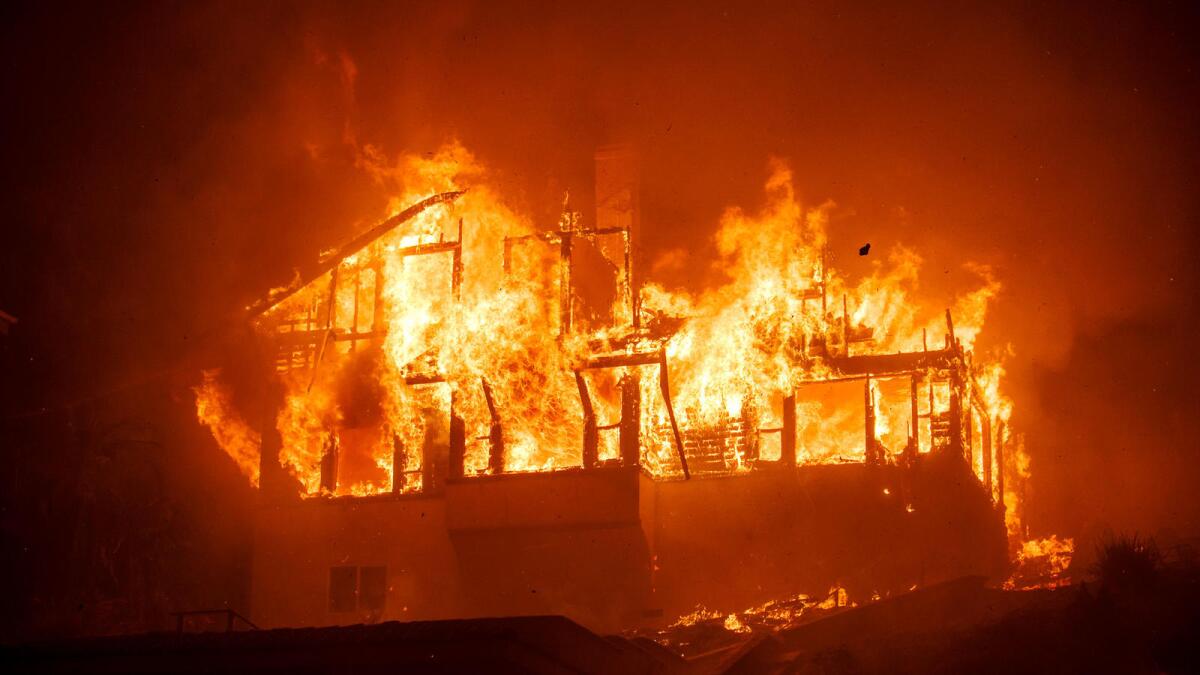
Tom and Jenny DiCiolli pulled up to their Ventura home Wednesday afternoon only to find mounds of rubble and ash.
They had learned about the condition of their home last night after a coworker walking through the neighborhood surveyed the damage.
“It’s sad,” said Jenny DiCiolli, 63. “It would be one thing if it was just a couple houses.”
“It’s devastating,” her husband said. “A lot of communities and a lot of lives have been changed.”
Tom DiCiolli said the couple had been asleep for about an hour on Monday night when they were told to evacuate.
“You wake up to this and you have only 15 minutes to consider what to take,” the 63-year-old said.
Jenny grabbed the documents for the house and birth certificates while he grabbed his computer and some photo albums — something his wife hadn’t realized.
“You took them?” she asked, surprised. “I was crying over them.”
Tom DiCiolli called the experience a “very surreal event.” The hills behind them were scorched black, and their neighbors’ homes on both sides were also burned. All that remained was their singed chimney, their washer and dryer, and a brand new fence the neighbor had just installed.
“I don’t think we’re banking on finding anything,” he said. “So any memorable item, from a blanket to a pendant” would be nice.
- Share via
In Indian Springs, she watched the sky light up — then, the fire spread
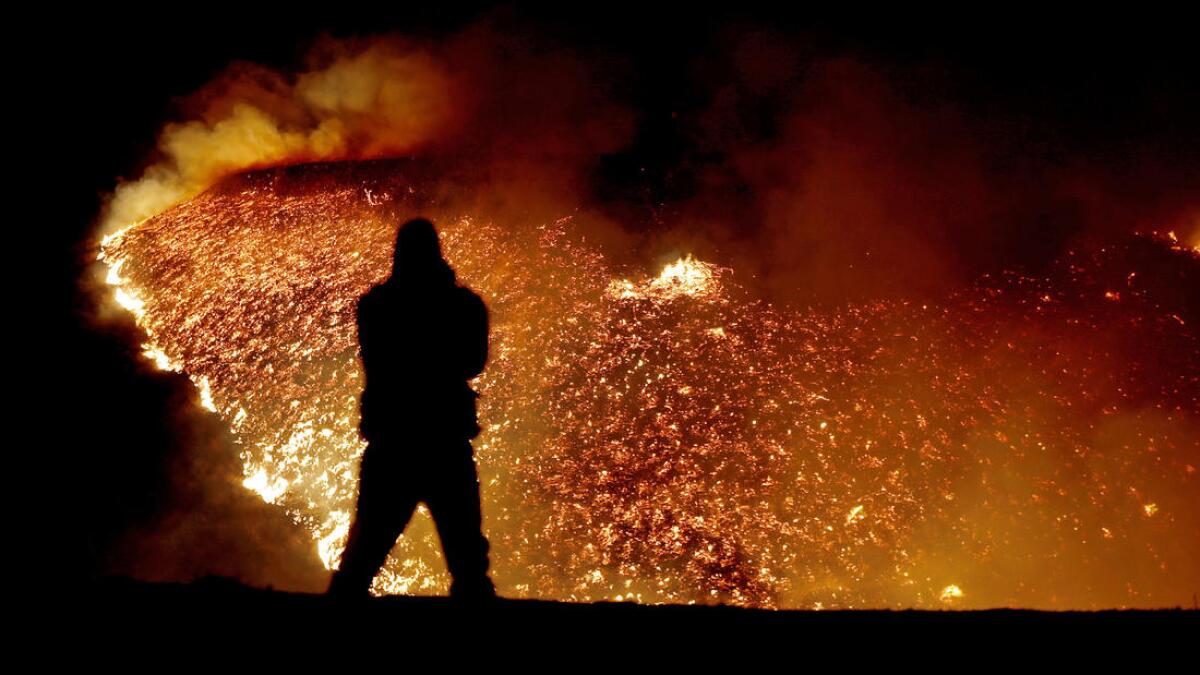
Gail Thackray has lived at Indian Springs Ranch along Little Tujunga Canyon Road for about 25 years.
She’s been through fires before, but then there was more time to evacuate.
Thackray’s mom was awake early Tuesday, worried about the wind’s banging. She looked outside and saw the nearby pylon sparking.
It looked “like one of the wires had come loose and it was smacking the hill,” Thackray said. “The wire would hit one part of the hill and that would explode and then another part of the hill. Within seconds the whole sky was lit up.”
Her 81-year-old mother called her screaming about 3:30 a.m. Thackray pulled back the curtains and saw sparks coming off the pylon and everything on fire.
“It spread each direction and we didn’t have time to get anything,” Thackray said. She lives in her house with her 12-year-old daughter; her mother lives in a cottage nearby.
When she woke her daughter, she told her they didn’t have time to grab anything, to just get in the car. She left with her mom and her daughter.
“If we’d been asleep when it happened, we would have been gone. It was that quick,” she said.
They didn’t have time to let the horses loose and she doesn’t know whether her St. Bernard survived.
As they left, they found themselves driving through a wall of fire, Thackray said. The fire followed them as they raced out.
“It was faster than anything I’ve ever seen,” she said.
Her two little ponies died, she said Wednesday, her voice breaking. Her bigger horse seems to have jumped out, but they’re unsure whether it survived.
“If we had taken an extra 30 seconds, we could have all been dead,” Thackray said.
Thackray lost her home in the fire. She also lost a guest house, a studio and her office. Her mother’s small home survived the blaze.
“We’ll probably live there, try to get help rebuilding and try and put our life back together,” she said. “But we got ourselves out. It could have been worse.”
- Share via
Red flag warning, indicating extreme fire danger, extended through Saturday in Los Angeles and Ventura counties
A red flag warning has been extended through Saturday across much of Southern California as firefighters struggled to get a handle on several wildfires raging across the region.
The warning, which indicates extreme fire danger due to gusty winds and low humidity, will be in effect through Saturday in Los Angeles and Ventura counties, where fires have scorched more than 80,000 acres and destroyed many homes.
Weather officials expect winds to pick up Wednesday night through Thursday, bringing “damaging” gusts of 50 to 70 mph that could cause trees and power lines to fall, and fire to spread rapidly. They also warned of isolated gusts of up to 80 mph in the mountains.
Winds will gradually weaken Friday and Saturday, officials said.
As of Wednesday morning, about 11,000 households were without power, according to Southern California Edison. Most of the outages were caused by the 65,000-acre Thomas fire burning in Ventura County.
- Share via
Ventura residents return to retrieve their essentials and find devastation

Tom and Jenny DiCiolli pulled up to their Ventura home Wednesday afternoon only to find mounds of rubble and ash.
They had learned about the condition of their home the night before after a co-worker walking through the neighborhood surveyed the damage.
“It’s sad,” said Jenny DiCiolli, 63. “It would be one thing if it was just a couple houses.”
“It’s devastating,” her husband said. “A lot of communities and a lot of lives have been changed.”
Tom DiCiolli said the couple had been asleep for about an hour on Monday night when they were told to evacuate.
“You wake up to this and you have only 15 minutes to consider what to take,” the 63-year-old said.
Jenny DiCiolli grabbed the documents for the house and birth certificates while he grabbed his computer and some photo albums — something his wife hadn’t realized.
“You took them?” she asked, surprised. “I was crying over them.”
Tom DiCiolli called the experience a “very surreal event.” The hills behind them were scorched black, and their neighbors’ homes on both sides were also burned. All that remained was their singed chimney, their washer and dryer, and a brand-new fence the neighbor had just installed.
“I don’t think we’re banking on finding anything,” he said. “So any memorable item, from a blanket to a pendant,” would be nice.
- Share via
Firefighters allow some Bel-Air residents to return and collect their belongings
By early afternoon, the fires had subsided but firefighters continued to guard the multimillion dollar homes in Bel-Air from the blazes that earlier in the morning came within feet of the properties.
The firetrucks spread out on Moraga Drive; one fire truck guarded every three houses, said Don Batiste, an engineer with the Los Angeles Fire Department. Firefighters said they weren’t sure how the Skirball fire had spread to Morago Drive.
There are about 36 homes in the gated community. All are surrounded by hills that were engulfed in flames Wednesday morning. Neighbors said well-known public figures and celebrities such as Jerry West and Rupert Murdoch live on the street. Magic Johnson once owned a house on the street, neighbors said.
Residents in the community were woken up at 5 a.m. Wednesday by police demanding they evacuate. “Everyone was great about evacuating. They didn’t get in the way,” said Captain John Ziola with the Los Angeles City Fire Department. “They were emotional, though.”
Ziola said he is proud of the firefighters. He pointed to the hills above and said that at least four homes were destroyed by the fire. Ziola said he is worried that the winds will pick up again Wednesday night.
By 2 p.m., some residents were allowed back in to grab a few belongings. Terri Greenbaum, who lives in a two-story gray home on the 1200 block of Moraga Drive, stood on her front lawn next to her doormat, which had burned. “That’s how close the flames got,” she said, pointing to it.
Greenbaum said she and her husband were woken up by the police knocking on their doors telling them to leave. She stuck her head outside the house and saw the flames for herself. “My husband and I threw our clothes and computers into the car and left,” she said. There was no damage to the house itself, her home for 15 years. “I was a little worried when I saw the firetruck outside when I was coming up,” she said. “But my home is fine for now.”
- Share via
To some, the oaky ash in Faria Beach looks like snow, or an ‘upside down Christmas’
Brent Clark, 58, stood on the roof of his Faria Beach home and began watering the wooden roof tiles. Past the railroad tracks and Highway 1, flames made their way down the hillsides as they burned through acres of chaparral.
Looking at the flames, Kay Clark, 58, turned her attention to a cypress tree near their home.
“That tree worries me,” she said.
The erratic wind shifts had driven the Thomas fire as far as Hobson Beach Park, which sits about three miles north from of Faria Beach.
The fire has kept residents nervous even here.
“Everything depends on what the winds do,” Brent Clark said.
Tuesday night, residents of Faria Beach were told to evacuate as flames made their way over a ridge and began to approach the small beach community. The fire was headed toward Solimar Beach, just south of Faria Beach.
Among those evacuated was Joe Ruffner, 65.
“The wind was blowing north, south, sometimes it seemed like it was doing both at the same time,” Ruffner said.
Kay Clark said she noticed “fire whirls” as the flames continued to approach the seaside town.
The fire left all the beach communities without power Tuesday. Wednesday was Day Two.
Eating a chocolate pastry, Ruffner hoped the power would come back soon.
Nearby, Jim Petit, 82, used a generator to keep power in his home. He said he put five gallons of gasoline into the generator in the morning and used a timer to keep track of it.
Outside their homes, Petit and Kay Clark talked.
“We’re not out of it yet,” Petit mentioned.
“We’re still not out of the woods,” Key Clark said.
As hours went by, ash settled on beach rocks, on cars, even the hair of onlookers who cut through the beach town to photograph the fire. At least three Amtrak Surfliners passed through the town, even as the fires raged on.
The ash, upon a closer look, consisted of burned leaves, mostly oak.
Ruffner said he was surprised to see how far the charred oak had travelled.
“It brings a whole new meaning to the phrase ‘fall leaves,’” Kay Clark said. “It looks like it’s snowing. It’s like Christmas. An upside-down Christmas.”
Nineteen miles North, residents in La Conchita braced for the worst as they watched the orange hazy smoke at a distance. Two-story and single-story homes sit along the base of the hillsides. The buildings sit next to each other with very little space in between. The neighborhood is surrounded by dry chaparral and other plants that have not burned for decades. Some residents watered their roofs, and others packed things into cars and trucks. A few focused on getting their horses from a nearby stable.
Like everybody else, this small beach community was on edge. Residents wondered what the winds would bring.
- Share via
Fire damages Ojai Valley School’s upper campus, but administrators are determined to reopen for spring semester
Mike Hall-Mounsey, president and CEO of the Ojai Valley School, visited the hilltop upper school campus Wednesday to survey the damage wrought by the Thomas fire.
The school’s two-story dormitory for girls, which also has apartments for faculty, was destroyed. The science and technology building, erected about a decade ago with labs, lecture halls and classrooms, was leveled by the flames. Classroom doors were charred, and a part of the boys’ dormitory sustained damage.
“It came through here — gale-force winds with embers,” Hall-Mounsey said. “Winds burst doors open. Embers reached into attics and windows. The firefighters said they couldn’t save it all. They saved what they could.”
The rest of the fall semester has been canceled for the upper school, which has about 120 students — 40 of whom attend only for days. The rest board.
Administrators made the decision Monday night to evacuate and put students on two buses. They fled by 8:30 p.m. and were taken to the lower school campus, which was not damaged. As they drove off, Hall-Mounsey saw the lights of firefighters’ bulldozers on the ridge across the canyon, which sits over St. Thomas Aquinas College.
After they left, the blaze roared over the ridge and ripped through the canyon, kicking up embers that sent the fire hopscotching across campus. The head of the upper school and a maintenance worker stayed as long as they could to douse hot spots and protect the property.
No students or faculty were injured in the fire. Many, though, lost all their possessions. Family members of students, faculty and alumni also have had houses severely damaged or destroyed, compounding the loss, the president said. At the burned dorm, cracked bowls, a blackened oven and the charred remnants of an ironing board were among the rubble. Heat emanated from the pile of detritus.
Hall-Mounsey is hopeful, he said, as he walked past the smoldering science center. Typically the hilltop campus provides views of the entire Ojai Valley below. On Wednesday, under an orange sun and a smoky sky, he could barely see the floor of the charred canyons below.
“The bones of the campus are good. We can replace what we lost,” he said. “The heart and soul of the school is alive and well.”
He is determined to see the school reopen for the spring semester on Jan. 8, with some students housed in modular units on parts of the campus — such as the athletic fields — that were spared.
“A lot of our philosophy is about resilience, grit, backpacking and making do,” he said. “We will have a pioneers spirit when we come back.”
Alumni and family members from all over the world have expressed support and pledged to help the school rebuild. Ojai Valley School is among a number of private and boarding schools in the area that attract students from across the nation and around the world. About 40 upper school students hail from abroad, Hall-Mounsey said. Ojai Valley’s upper school campus is believed to be among the most damaged by the fire.
- Share via
Road-trippers save their dogs — and ditch their Civic — as they flee Rye fire

Over the thousands of miles traversed on a weeks-long road trip that started in Nova Scotia and passed through Simi Valley, Florida retiree Roy DeFilippis, 69, and his wife Yolanda, 66, had faced many challenges.
Their RV broke down in Kingman, Ariz., and again en route to Simi. Roy almost lost control of the motor home driving down a mountain.
Then, fire.
On Tuesday afternoon, at a campground west of Santa Clarita, Roy DeFilippis was watching TV, deciding whether to drink more coffee or switch to beer. “And all of a sudden, we hear sirens and sirens, and police came out and told me us we had to evacuate,” he said.
The DeFilippis stepped outside and saw flames as tall as their RV.
They ensured their most precious cargo — their eight Yorkshire terriers — was in the motor home and rushed onto Highway 126.
They left behind the Honda Civic they’d been towing. There was no time to hook it up.
The Rye fire has burned 7,000 acres and destroyed at least one structure.
On Wednesday, as 575 firefighters worked to contain the 7,000-acre fire, farmers and field workers continued their morning routines. Sprinklers watered a variety of crops, and citrus trees soaked up the sun.
Rich Brocchini, the public information officers for Cal Fire Team No. 6, said the fire is only 5% contained and urged residents to pay attention to Cal Fire’s online updates.
“Please stay updated,” he said. “This is going to be a pretty significant wind event for the next couple days.”
Late Wednesday morning, the DeFilippis parked in a gravel lot between Santa Clarita and Fillmore, waiting for the campground to reopen at noon. They weren’t sure whether their car survived.
- Share via
California Atty. Gen. Xavier Becerra warns against price gouging as fires rage
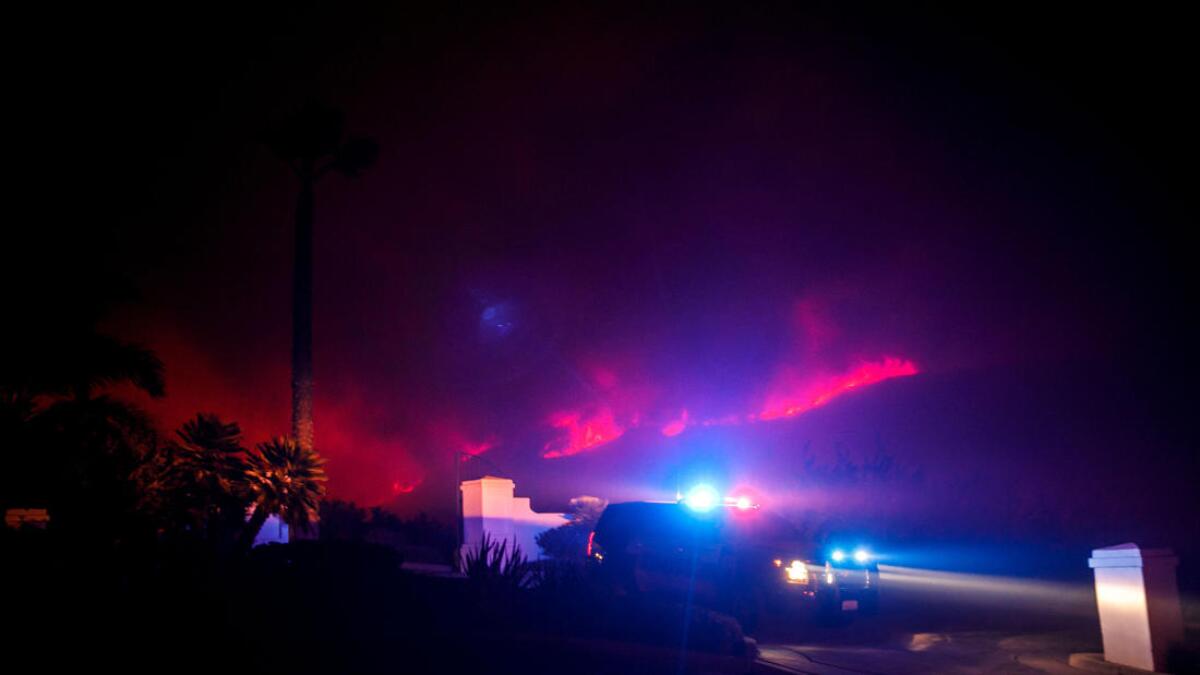
Jacking up prices for essentials during a state of emergency is illegal, California Atty. Gen. Xavier Becerra reminded Californians as wildfires continued to burn this week.
“As our brave firefighters are working to contain the blazes and as many Californians are being evacuated, it should not be open season on innocent victims,” Becerra said in a statement Wednesday. “Our state’s price gouging law protects people impacted by an emergency from illegal price gouging on housing, gas, food and other essential supplies.”
California law generally prohibits charging a price that exceeds, by more than 10%, the price of an item before a state or local declaration of emergency. (There are some exceptions, including a significant increase in the price of labor or materials for the business.) Those who violate the law could face one year of imprisonment, and/or a fine up to $10,000.
Becerra asked anyone who believes they’ve been a victim of price gouging to file a complaint through his website or by calling (800) 952-5225 or contacting local law enforcement.
“For any in the community who would give in to the temptation to benefit from others’ misfortune, we will take price gouging very seriously and will act to ensure it is not profitable,” Ventura County Dist. Atty. Gregory Totten said in the statement.
- Share via
Thomas fire reaches Faria Beach